Since in the previous sequel of my stories about travelling in Egypt I wrote about the visit to the Luxor Temple in 2001 which I did not visit in 2021, now I can completely switch to 2021 and say something about other important sites in Luxor which I visited both times, but using newer (and better) photographs and videos.
So, when you go on a day’s trip from Hurghada to Luxor, you have to count on a very early beginning of the day. In my case, I had to be in front of the hotel already at 4.10 am. The reason is that the visitors are first picked up at their hotels and then all the coaches and mini-buses gather at a large parking lot where some kind of control is carried out and only after that the excursion truly begins. We practically left Hurghada at 6.10 am.
 Leaving Hurghada
Leaving Hurghada
The road first goes through rather rocky desert, with lower and higher elevations.
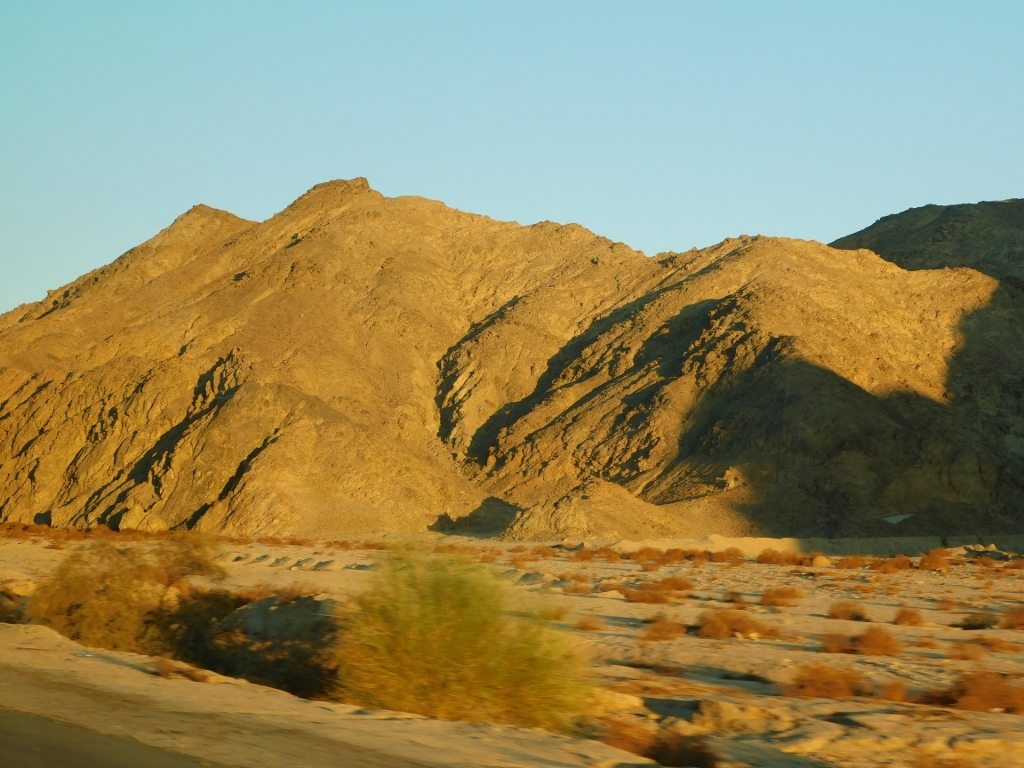 Landscape west of Hurghada
Landscape west of Hurghada
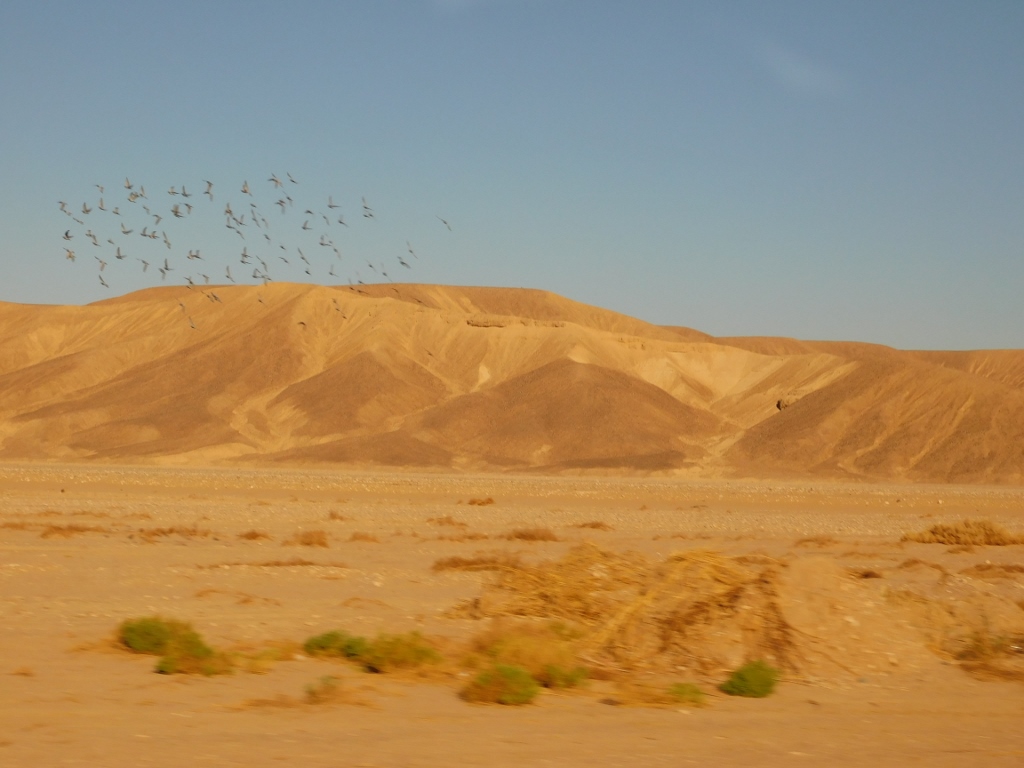 Landscape west of Hurghada
Landscape west of Hurghada
Then you get to the city called Qena in the surroundings of which there are a few interesting sites from the period of Ancient Egypt, but even the city itself is certainly worth a visit. This, of course, was not a part of our plan, so we only drove through and headed south, all the time following a canal.
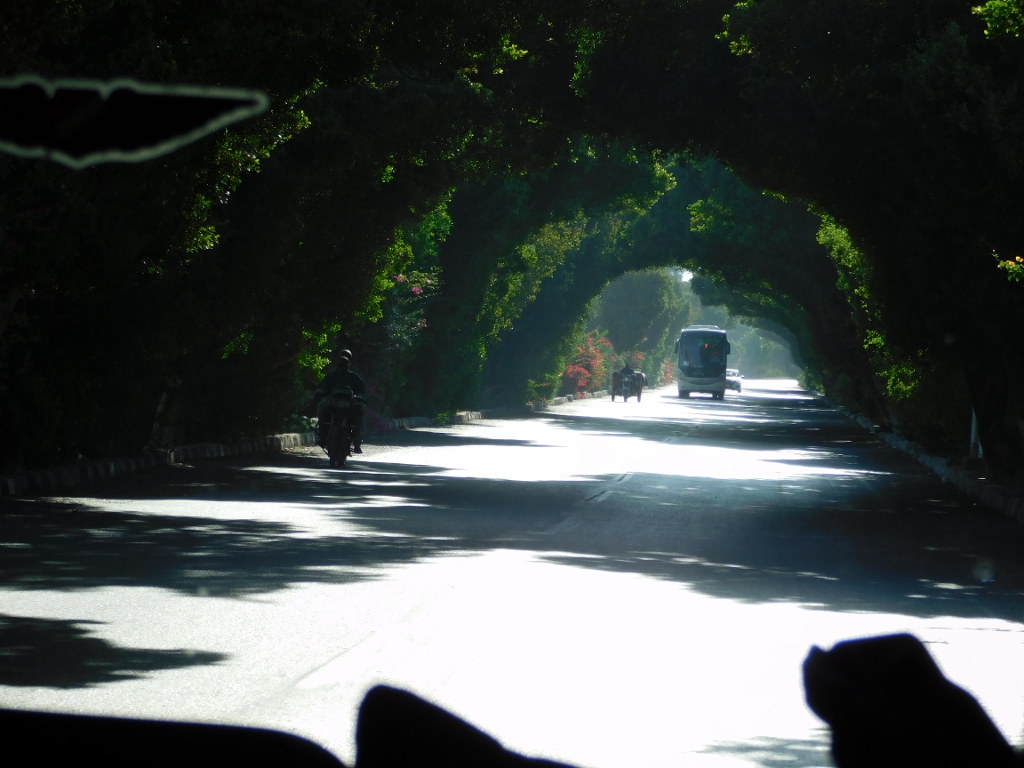 A part of the road from Qena to Luxor
A part of the road from Qena to Luxor
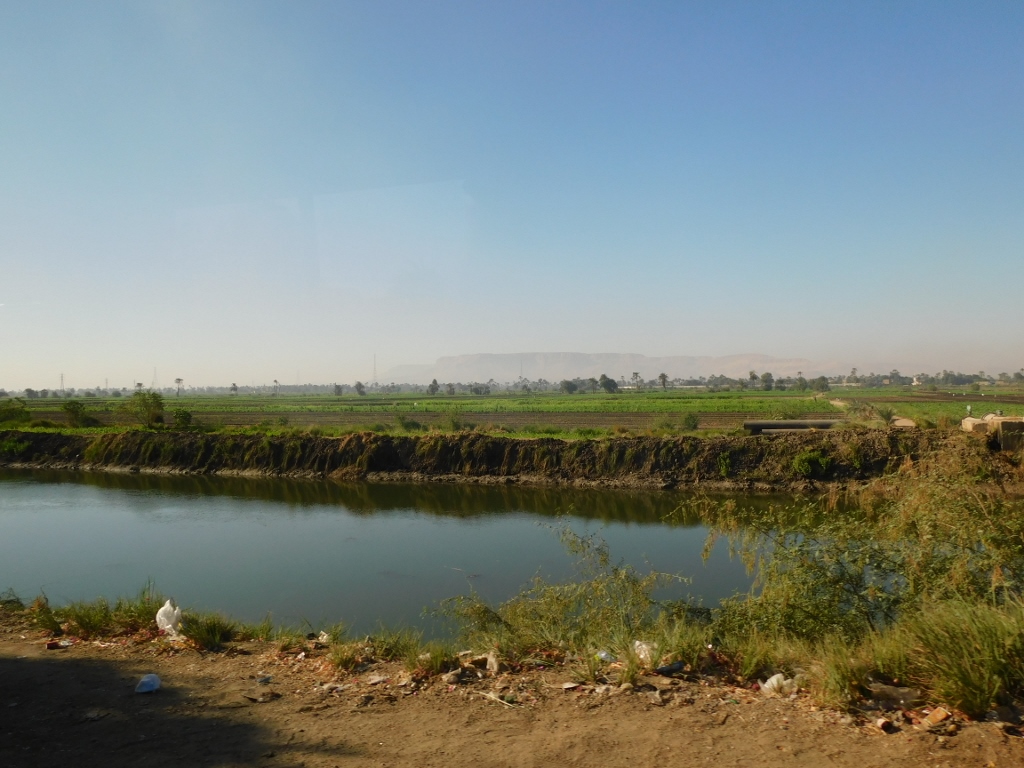 Canal beside the road from Qena to Luxor
Canal beside the road from Qena to Luxor
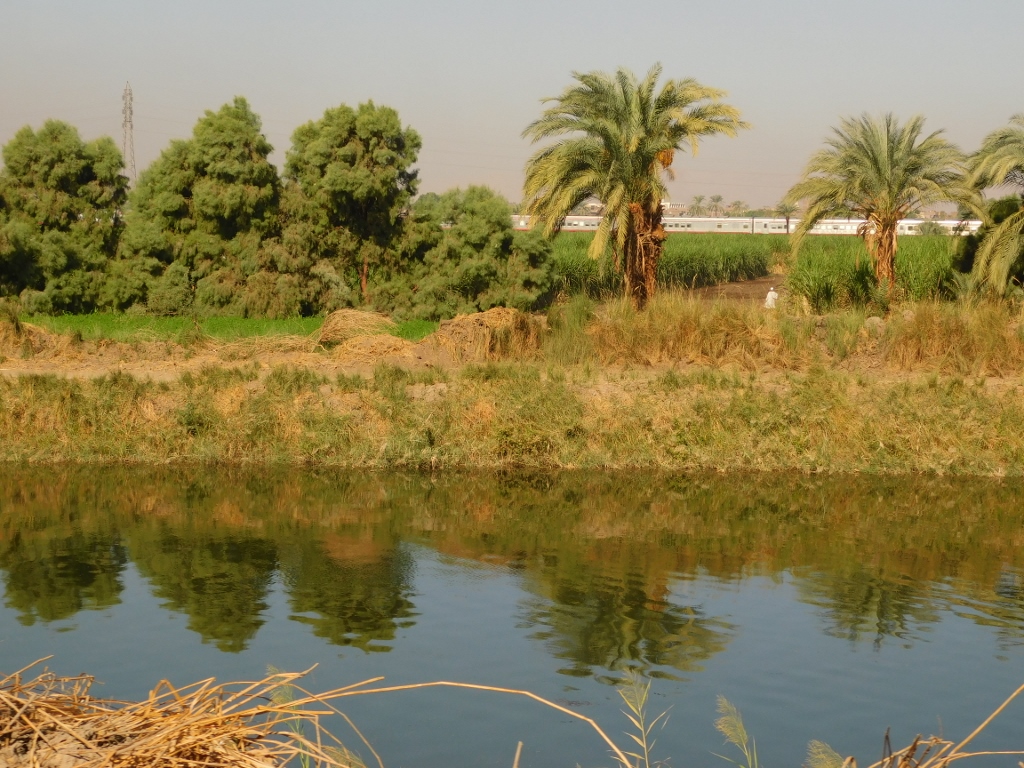 Canal beside the road from Qena to Luxor
Canal beside the road from Qena to Luxor
There are around 300 km between Hurghada and Luxor, but a stop is made on the way, plus there is a huge number of sleeping policemen on the road from Qena to Luxor, so we reached Luxor only after 10 am. We went immediately to the Karnak Temple Complex or simply Karnak (nowadays it is surrounded by a town of the same name).
Karnak was the north part of Ancient Egyptian Thebes and there is a huge temple complex there. The Egyptians like to say that this is the biggest temple complex in the world, but this honour belongs to Angkor Wat in Cambodia. Still, Karnak is the second largest and that is certainly no small feat.
The development of the temple follows the development of Thebes itself, which means that the temple started to develop more seriously from the period of the 11th dynasty (2130-1991 BCE). However, the main construction works were carried out during the reign of the pharaohs from the 18th and the 19th dynasties (1550-1189 BCE).
The temple complex consists of three precincts, each one of which is surrounded by an enclosure wall. The main segment is the Temple of Amun, south of it there is the Temple of goddess Mut and to the north there is the Temple of god Montu. I have already mentioned Amun and Mut in the previous sequel of my travelogue, but let me now give a short explanation about god Montu.
This is the Ancient Egyptian god of war, the embodiment of the pharaoh’s conquering vitality. It is interesting that he is also shown as a human figure with the head of a falcon, just like Horus. However, in order to tell one from the other, one should look at what they are wearing on their head. Horus wears the double crown of Egypt, the pschent, while Montu has a solar disc and two feathers. The lunar god Khonsu, son of god Amun-Ra and goddess Mut with whom he is jointly celebrateFd as the Theban Triad, is also often shown in the shape of a human figure with the head of a falcon, but in that case he wears a moon-disk on his head.
Still, the main part of the temple complex is the Temple of Amun and during both of my visits I saw only a part of this section. After all, this is the usual thing. Any more detailed visit to all the sections would require much more time.
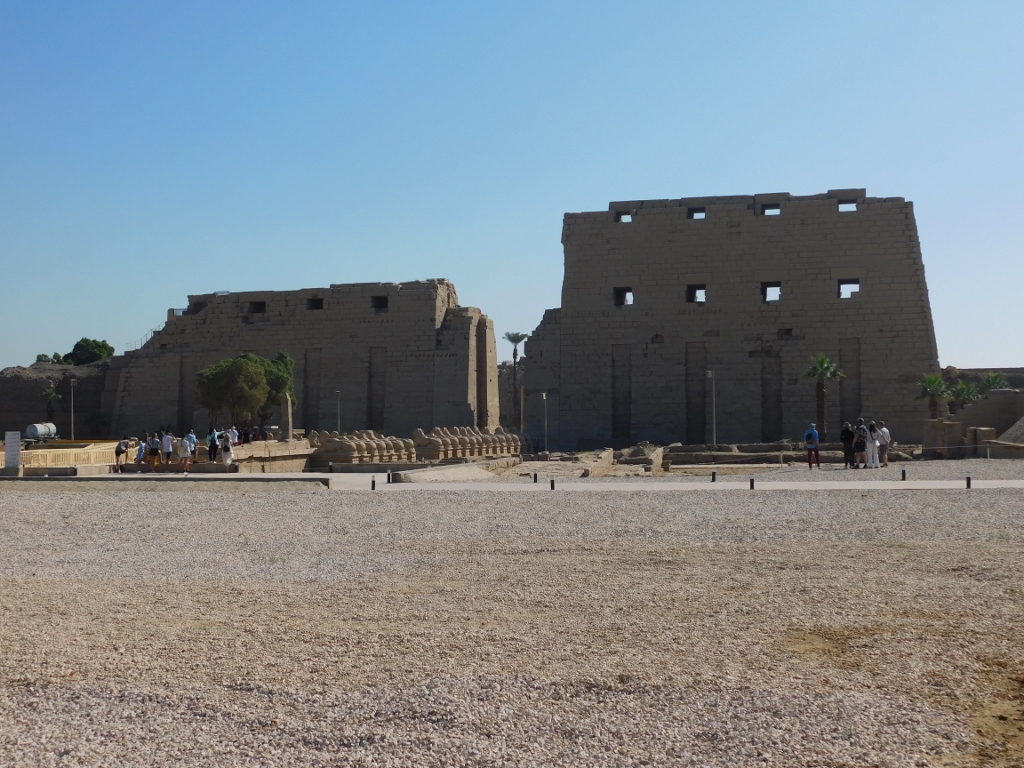 Approaching Karnak (Temple of Amun)
Approaching Karnak (Temple of Amun)
Opposite the entrance into the Temple of Amun, a little farther, there is the Nile and even farther on the west riverbank of the Nile there are remains of Western Thebes, which I am going to write about later on.
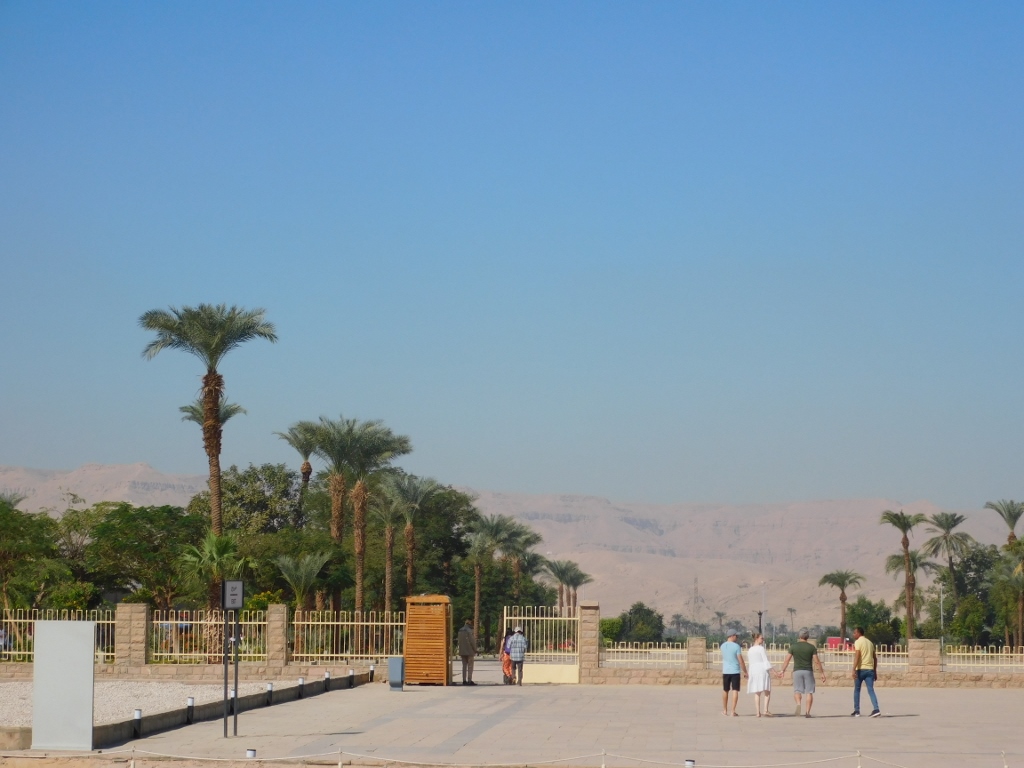 In the distance you can see mountains on the west bank of the Nile
In the distance you can see mountains on the west bank of the Nile
In order to enter the temple, it is necessary to go through two lines of sphinxes called the Corridor of Sphinxes. They are not a part of the Avenue of Sphinxes that I have already written about, which generally goes to the south in the direction of the Luxor Temple. These sphinxes actually used to lead to the quay because in the past, the riverbank of the Nile, which is now a few hundred metres away, used to be much closer to the temple. These lines of sphinxes go along the east-west axis, just like the main temple.
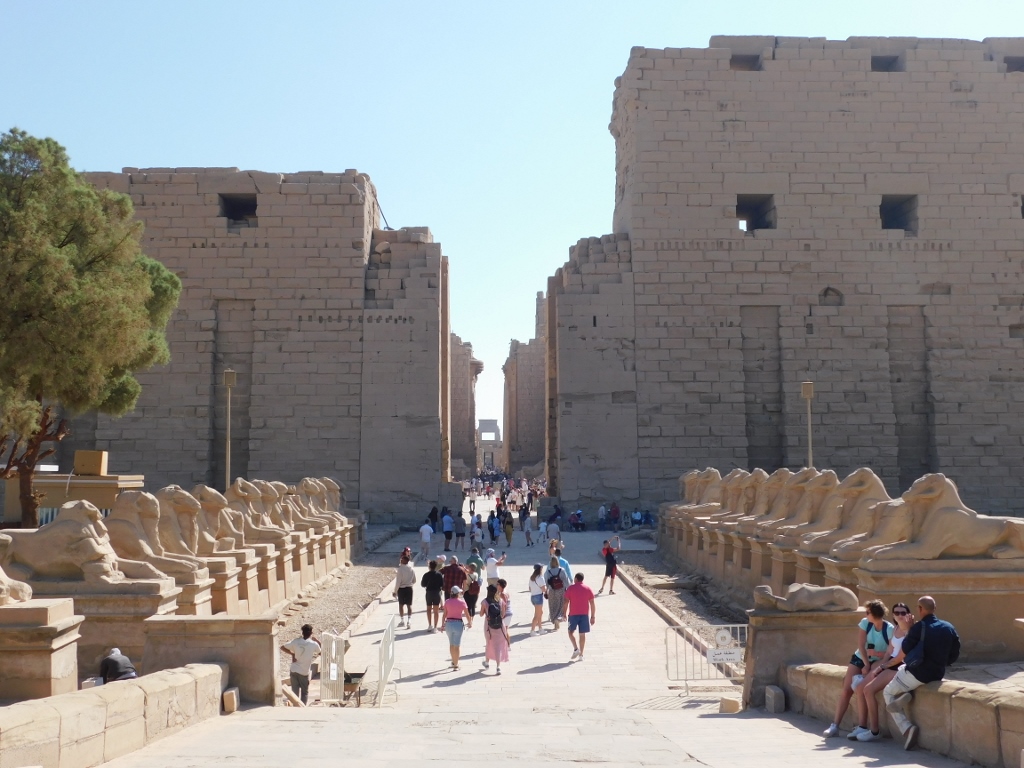 Lines of sphinxes in front of the First Pylon of the Temple of Amun in Karnak
Lines of sphinxes in front of the First Pylon of the Temple of Amun in Karnak
Needless to say, I had to take more photos of the sphinxes themselves.
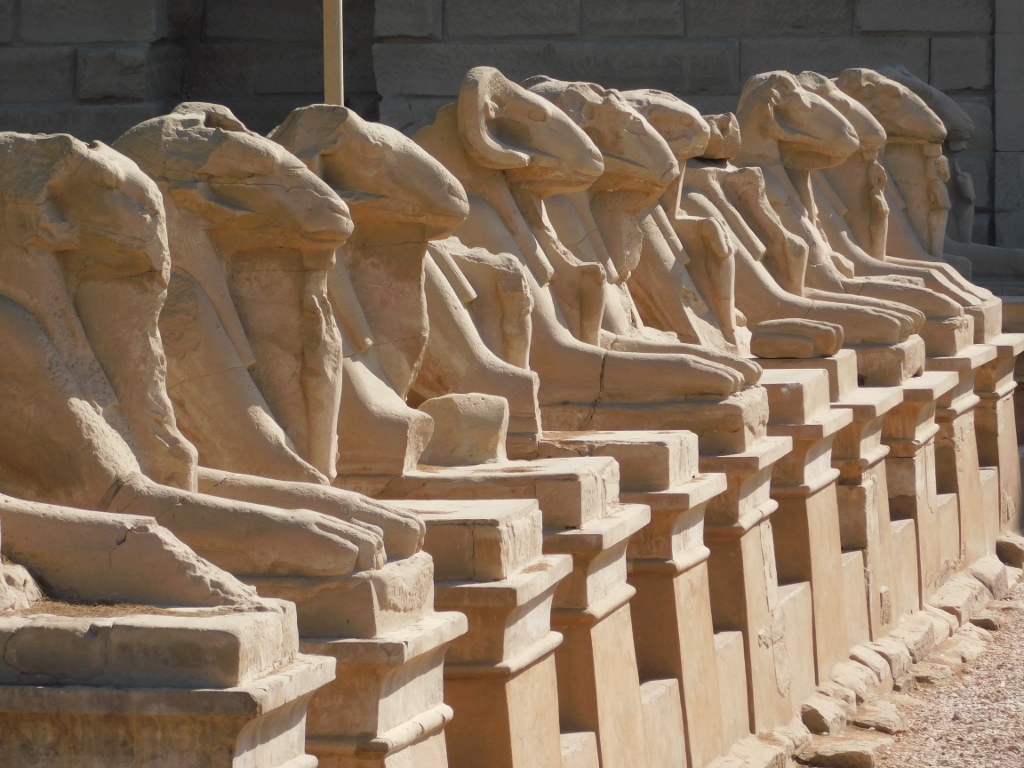 Sphinxes in front of the Temple of Amun in Karnak, a detail
Sphinxes in front of the Temple of Amun in Karnak, a detail
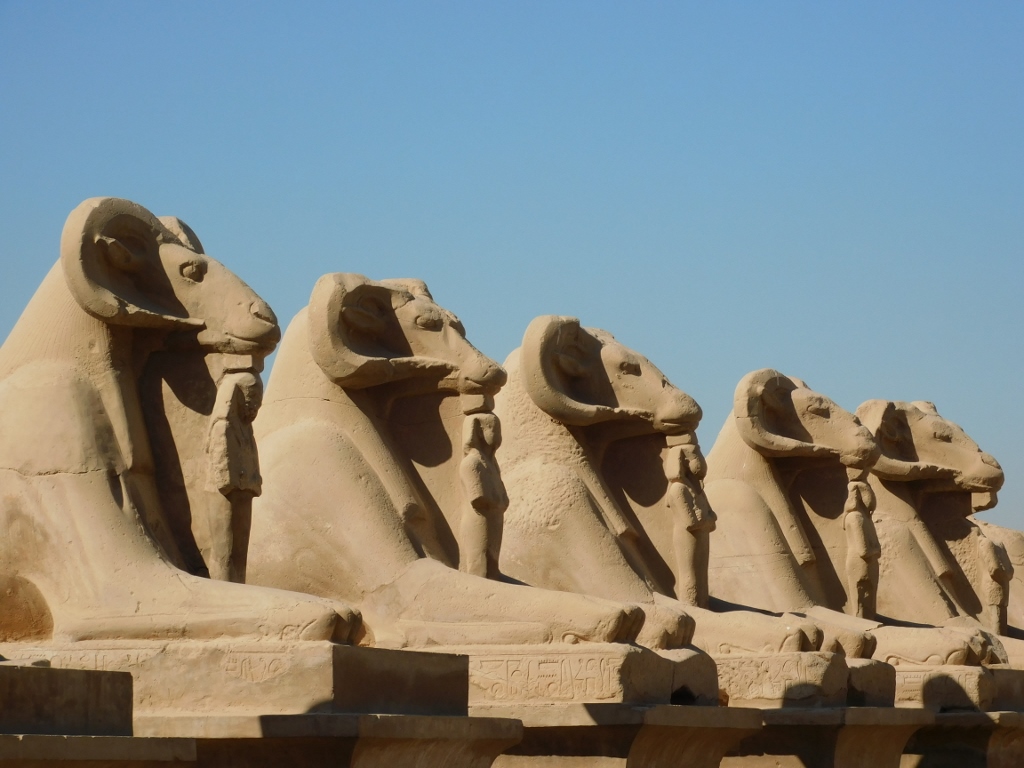 Sphinxes in front of the Temple of Amun in Karnak, a detail
Sphinxes in front of the Temple of Amun in Karnak, a detail
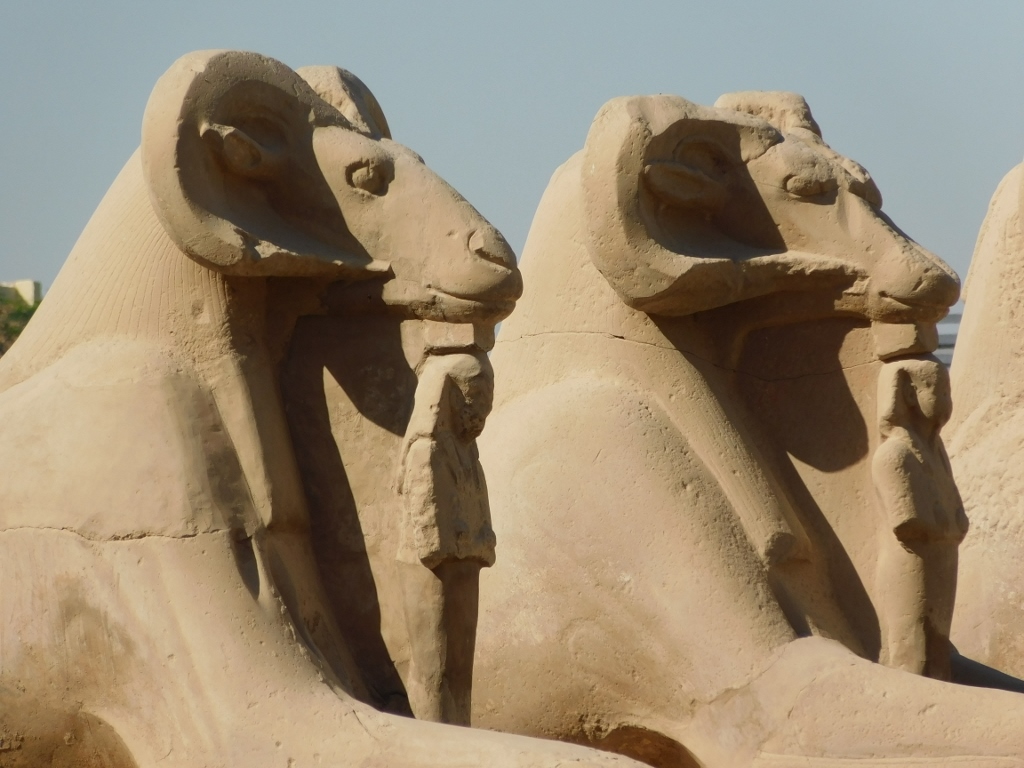 Sphinxes in front of the Temple of Amun in Karnak, a detail
Sphinxes in front of the Temple of Amun in Karnak, a detail
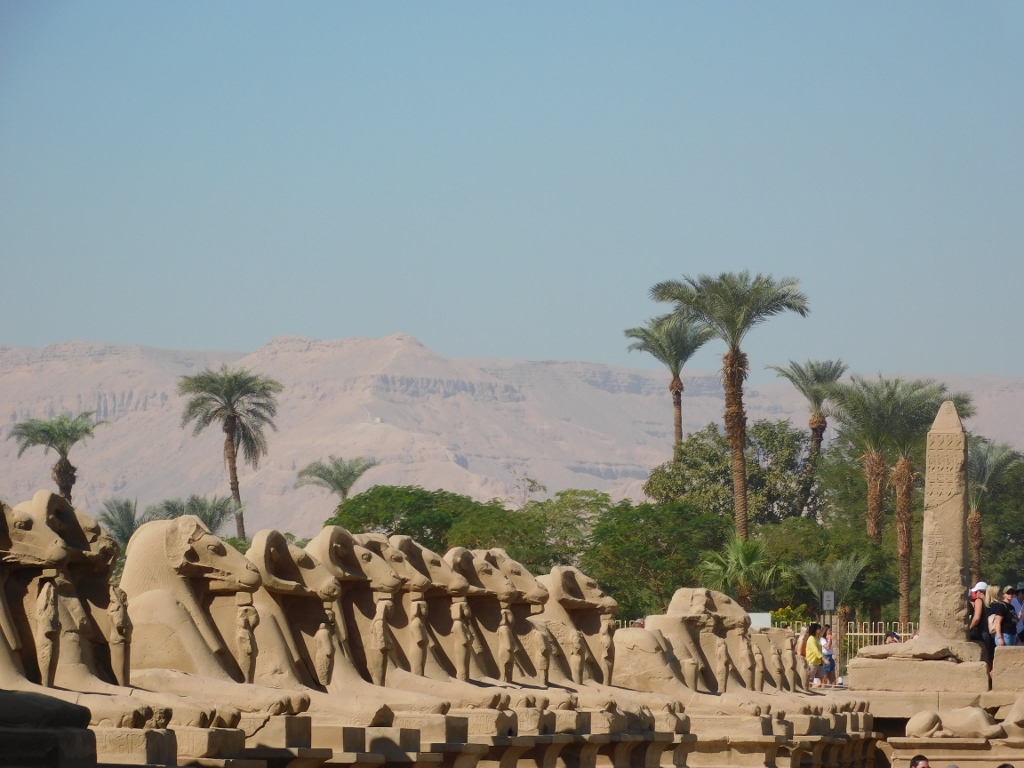 Sphinxes in front of the Temple of Amun in Karnak, a detail – the small obelisk to the right was erected by Pharaoh Seti II
Sphinxes in front of the Temple of Amun in Karnak, a detail – the small obelisk to the right was erected by Pharaoh Seti II
When you look towards the interior of the temple through the Corridor of Sphinxes in front of the Temple of Amun, you can see nicely that the line up of the structures leads towards the inner sanctum.
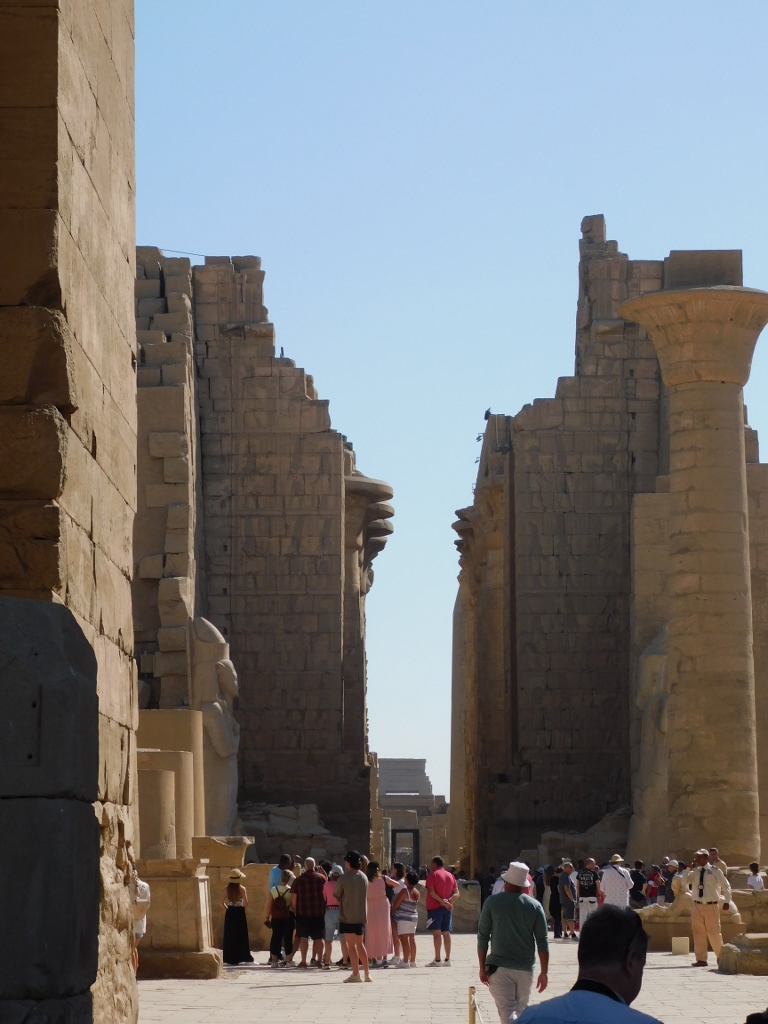 View from the entrance towards the interior of the Temple of Amun complex in Karnak
View from the entrance towards the interior of the Temple of Amun complex in Karnak
The temple is entered through the First Pylon. As a reminder, pylons are monumental gates that consist of a portal placed between two truncated pyramidal towers. It is precisely this aspect of the truncated pyramids that can be seen in the photo below that shows the right-hand section of the First Pylon seen from the outside. As it can be seen, there is no portal; only a passage between two sections of the pylon.
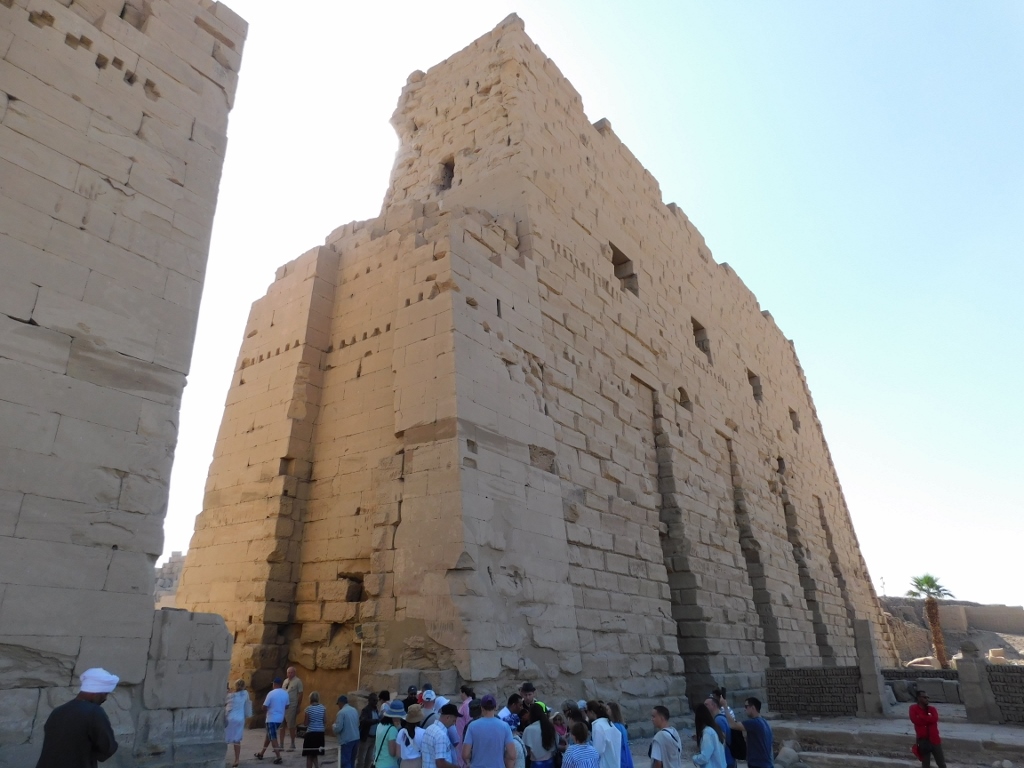 First Pylon
First Pylon
It is important to emphasise this “first” in connection with the pylon, since within the Amun section of the Karnak Temple Complex there are ten of them. Six are positioned parallel to the initial one, while the remaining four lead on the side in the south direction.
Once you pass the First Pylon, you enter the Great Court or atrium.
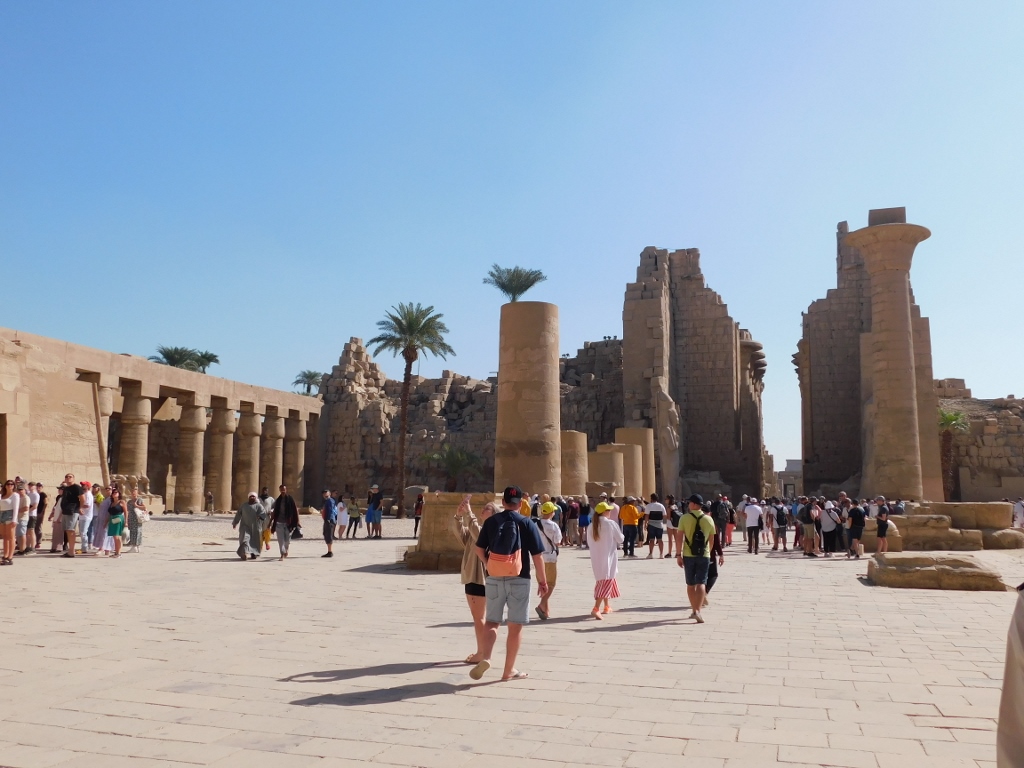 Great Court, the Amun section of the Karnak Temple Complex
Great Court, the Amun section of the Karnak Temple Complex
It is already here that you can see some of the important structures that exist within the Temple of Amun. When I say “the Temple of Amun,” it is important to point out that this is not one single temple, but an entire enclosed complex of temples and structures within the overall Karnak Temple Complex dedicated to the main god Amun.
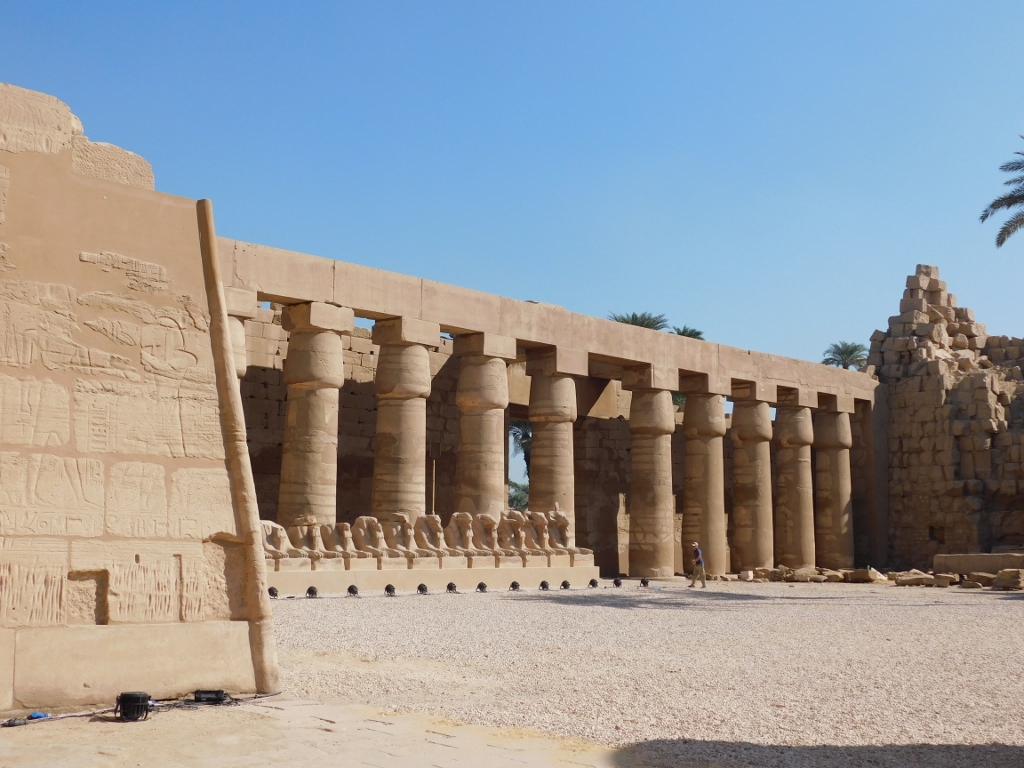 Colonnade with sphinxes on the north side of the Great Court
Colonnade with sphinxes on the north side of the Great Court
The sphinxes that symbolise god Amun-Ra are shown here with the body of a lion and the head of a ram underneath the chin of which there is a sculpture of Pharaoh Ramesses II.
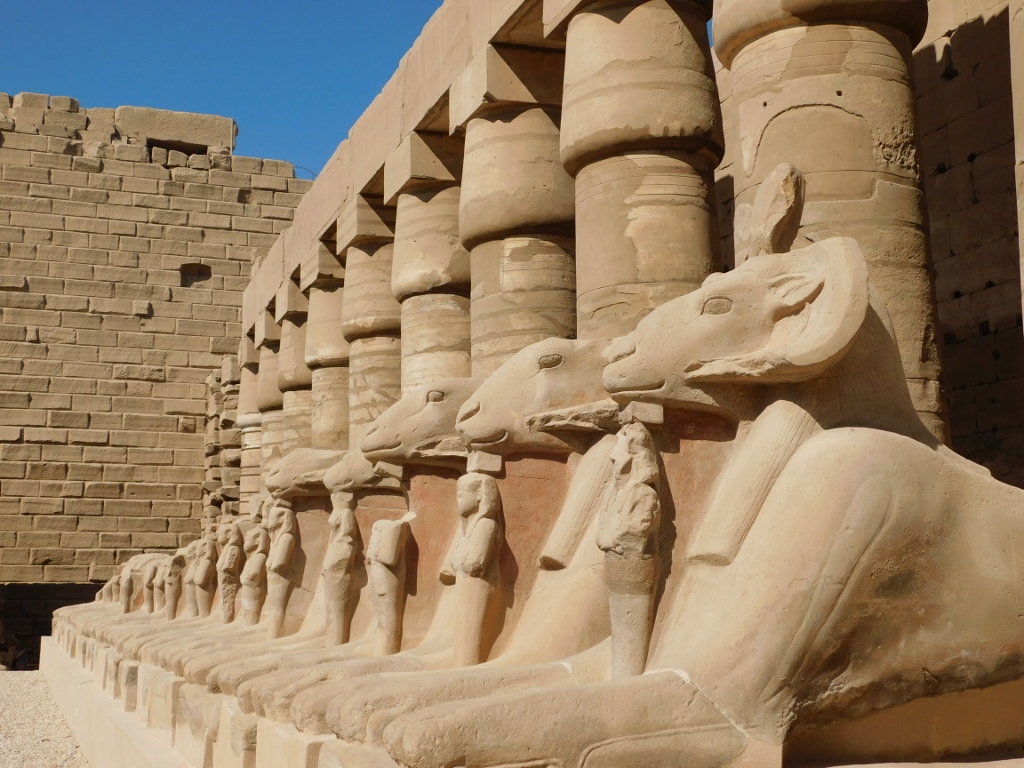 Sphinxes beside the colonnade on the north side of the Great Court
Sphinxes beside the colonnade on the north side of the Great Court
On the north side there is also the small Temple of Seti II consisting of three separate rooms placed one next to the other. Each one of these smaller temples is dedicated to a different deity of the Theban Triad – Amun, Mut and Khonsu.
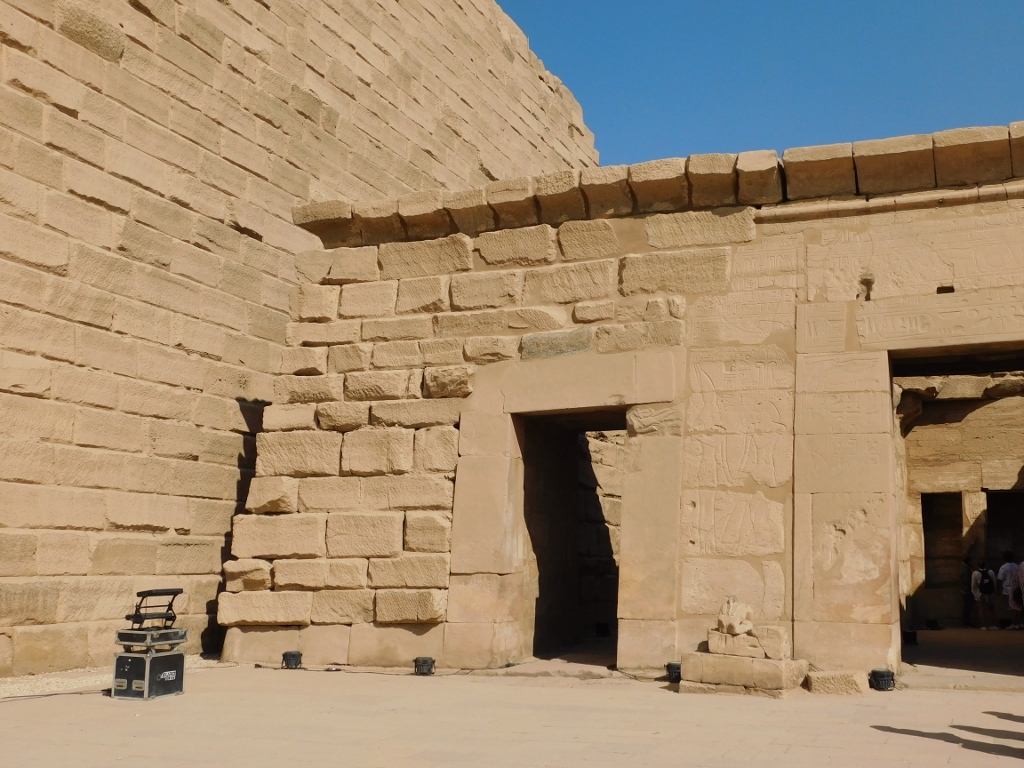 Part of the Temple of Seti II built right next to the back side of the First Pylon
Part of the Temple of Seti II built right next to the back side of the First Pylon
In addition to the sphinxes next to the colonnade on the north side, they can be seen in other parts of the Great Court as well.
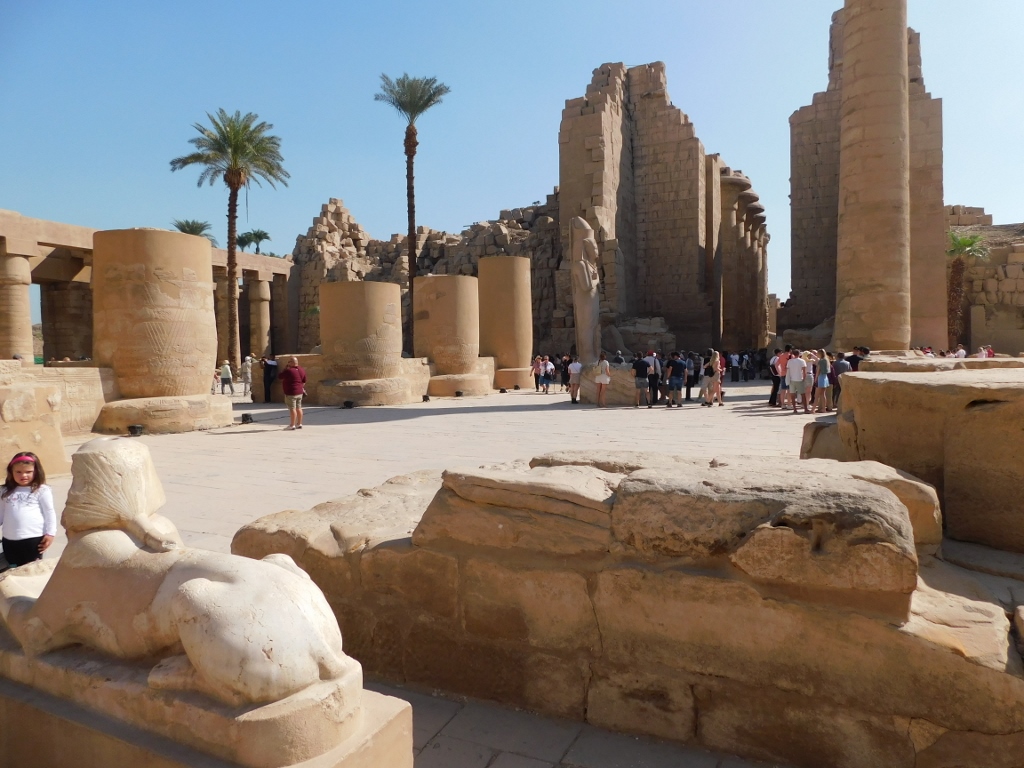 Great Court, a lonely whole sphinx in the central part of the court
Great Court, a lonely whole sphinx in the central part of the court
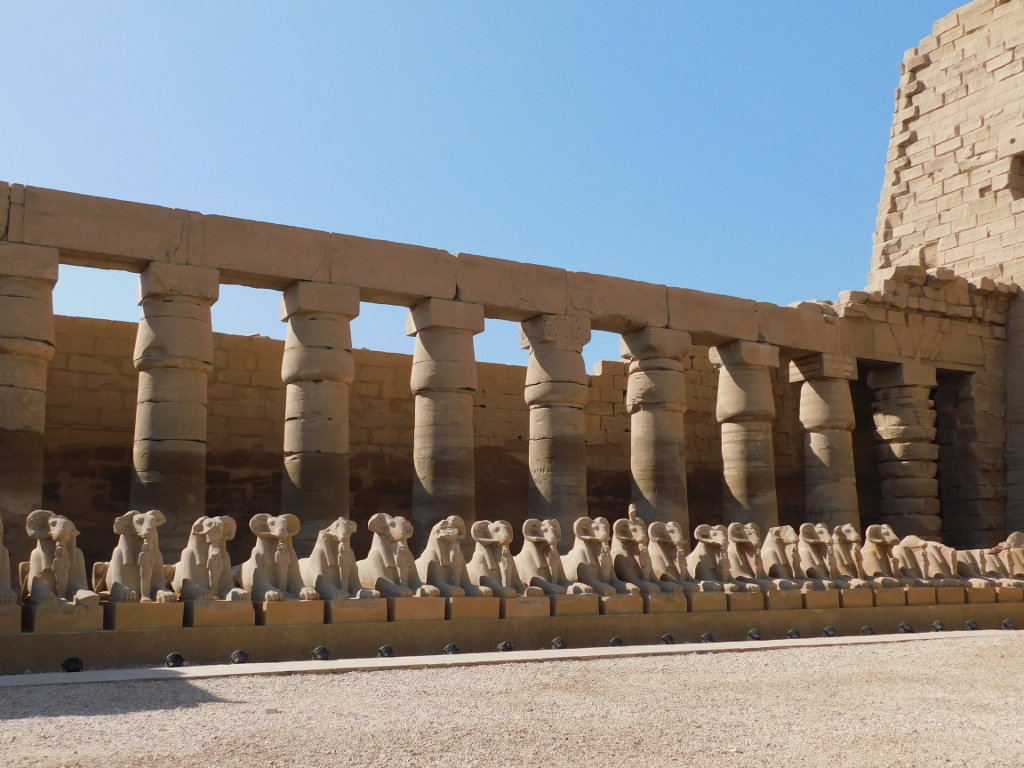 A line of sphinxes in front of the colonnade on the south side of the Great Court
A line of sphinxes in front of the colonnade on the south side of the Great Court
On the south side of the Great Court there is also the Temple of Ramesses III.
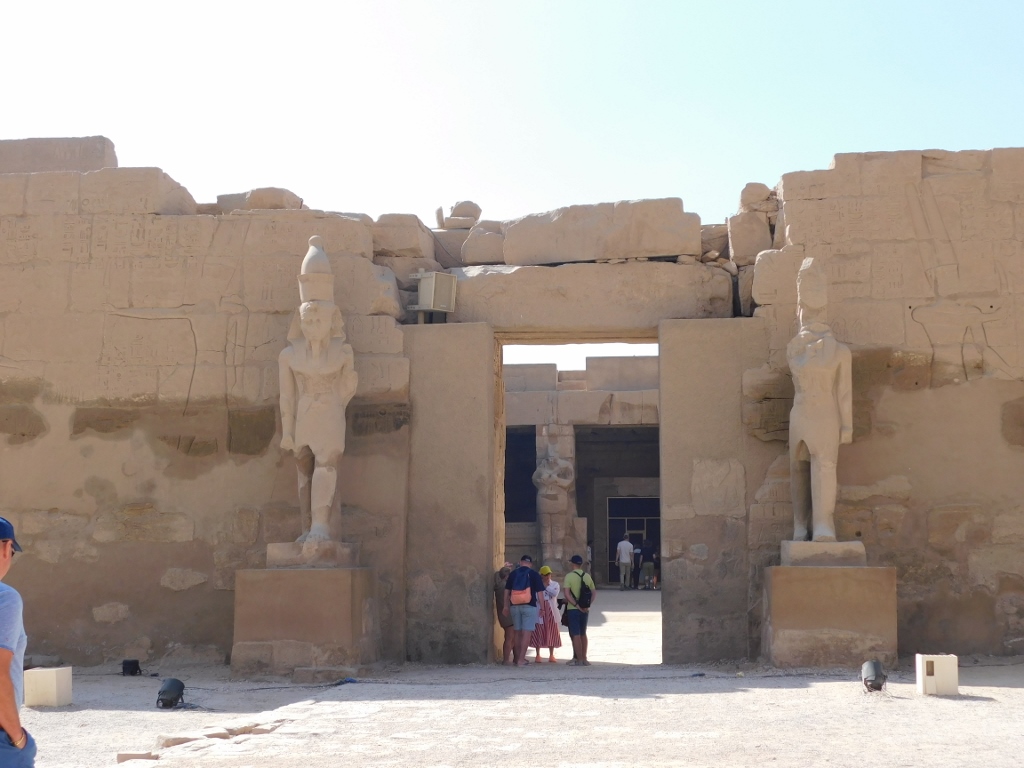 Great Court, entrance into the Temple of Ramesses III
Great Court, entrance into the Temple of Ramesses III
It has become quite clear to me here that I will not have enough time to see everything nicely and in detail, so I continued towards the central part of the main temple. The next section, behind the Second Pylon, is the Hypostyle Hall, i.e., a hall with columns. Still, before entering that section, the visitor should note the free-standing colossal statue of Ramesses II on the left-hand side.
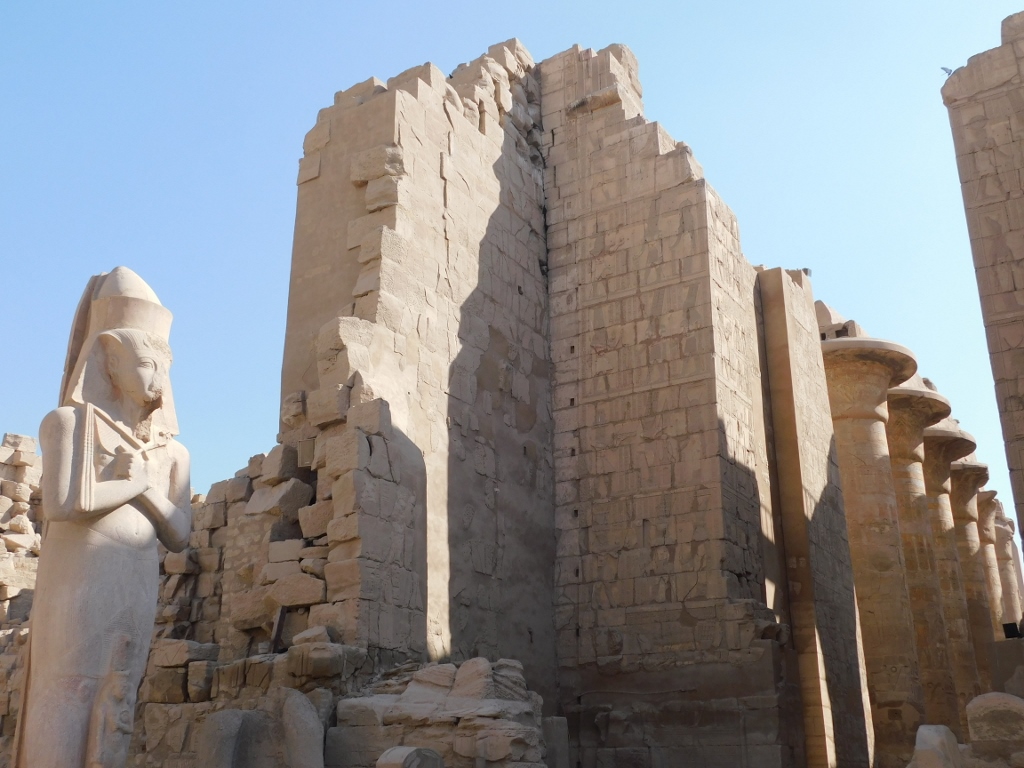 Statue of Ramesses II, a part of the Second Pylon, while on the right-hand side there are the columns in the Hypostyle Hall
Statue of Ramesses II, a part of the Second Pylon, while on the right-hand side there are the columns in the Hypostyle Hall
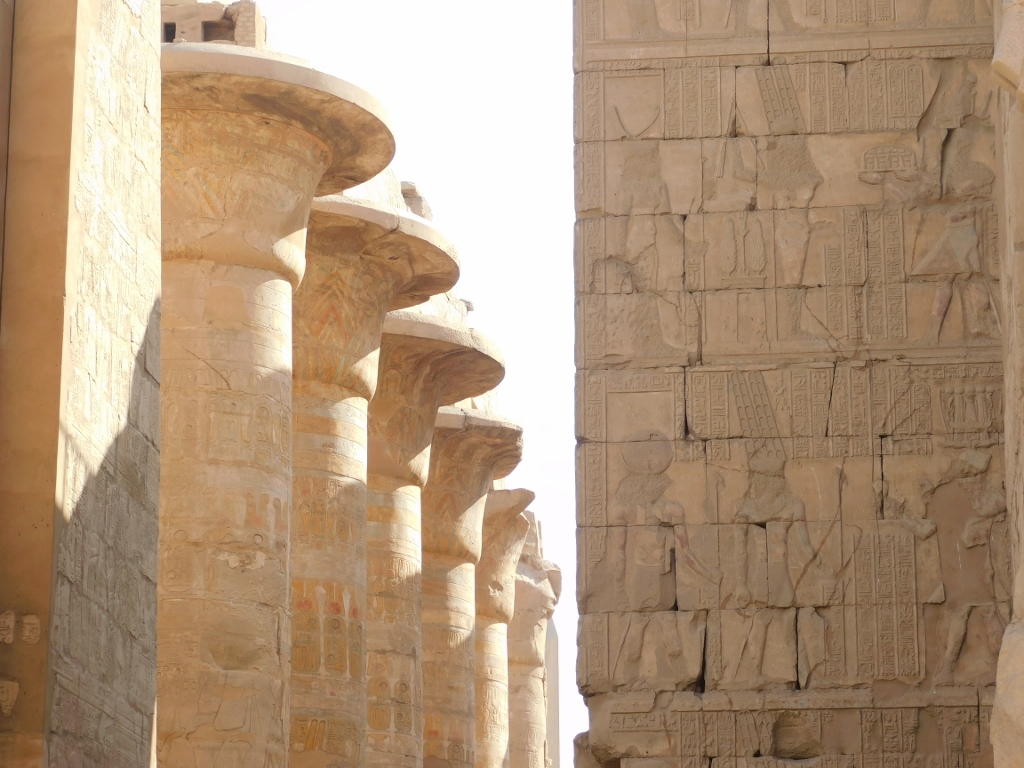 Part of the Second Pylon (right) and the central columns in the Hypostyle Hall
Part of the Second Pylon (right) and the central columns in the Hypostyle Hall
The Great Hypostyle Hall is one of the most visited monuments in Egypt. And this is no coincidence. This is an exceptionally impressive space built during the reign of Seti I (father) and Ramesses II (son) from the Ancient Egyptian 19th dynasty, in the 13th century BCE.
Hypostyle hall is the name for a large room covered by a roof carried by columns. Over time, the roof collapsed, but most of the columns have survived. Over a surface area of 5000 square metres, there are 134 columns arranged in 16 rows. Half of them are on the left-hand side and half of them are on the right-hand side of the central passage. The columns that are arranged beside the central passage, in other words two rows of columns, are higher and have a larger circumference towards the top than the rest of them. They are 24 m high and the circumference on the top is 10 metres. The lower columns are “only” 16 m high. All the columns have capitals in the shape of papyrus, with a note that the central ones show an open papyrus flower, while the remaining ones have a closed papyrus flower. This symbolises the ancient swamp from which the self-created god Amun rose at the beginning of the creation. There is also a story that the central passage symbolises the Nile river itself, while the papyrus plant grows faster and higher next to the water, which would also explain the reason why the central columns are higher than the rest of them.
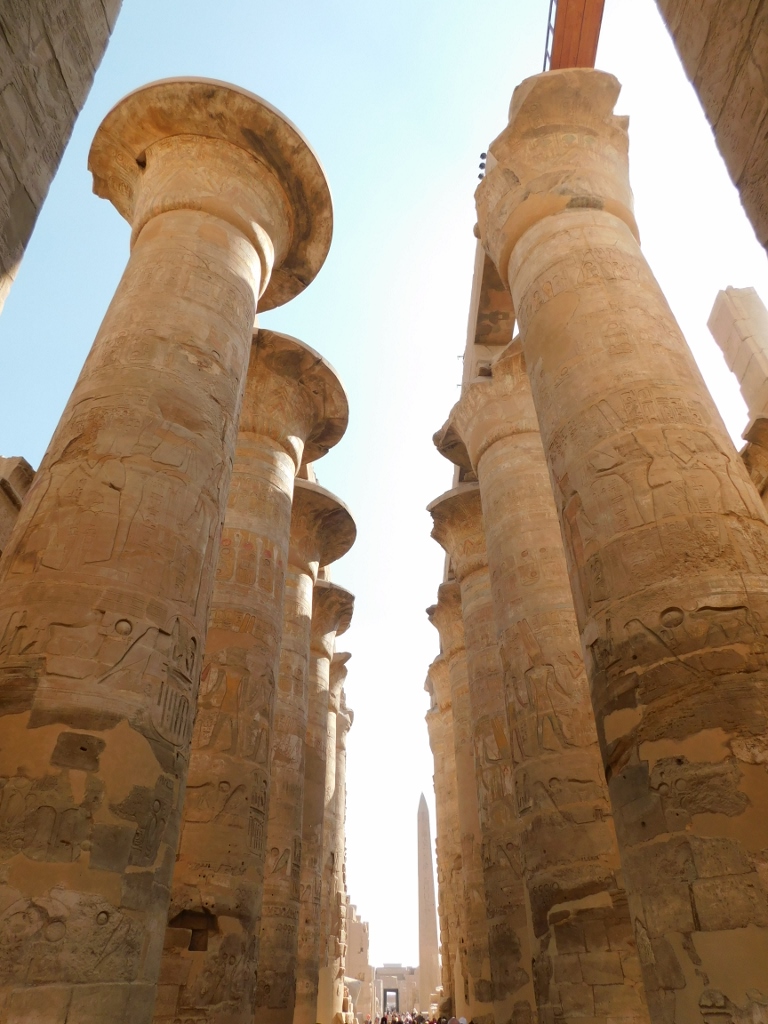 Central row of columns in the Hypostyle Hall (in the distance you can see the Obelisk of Thutmose I)
Central row of columns in the Hypostyle Hall (in the distance you can see the Obelisk of Thutmose I)
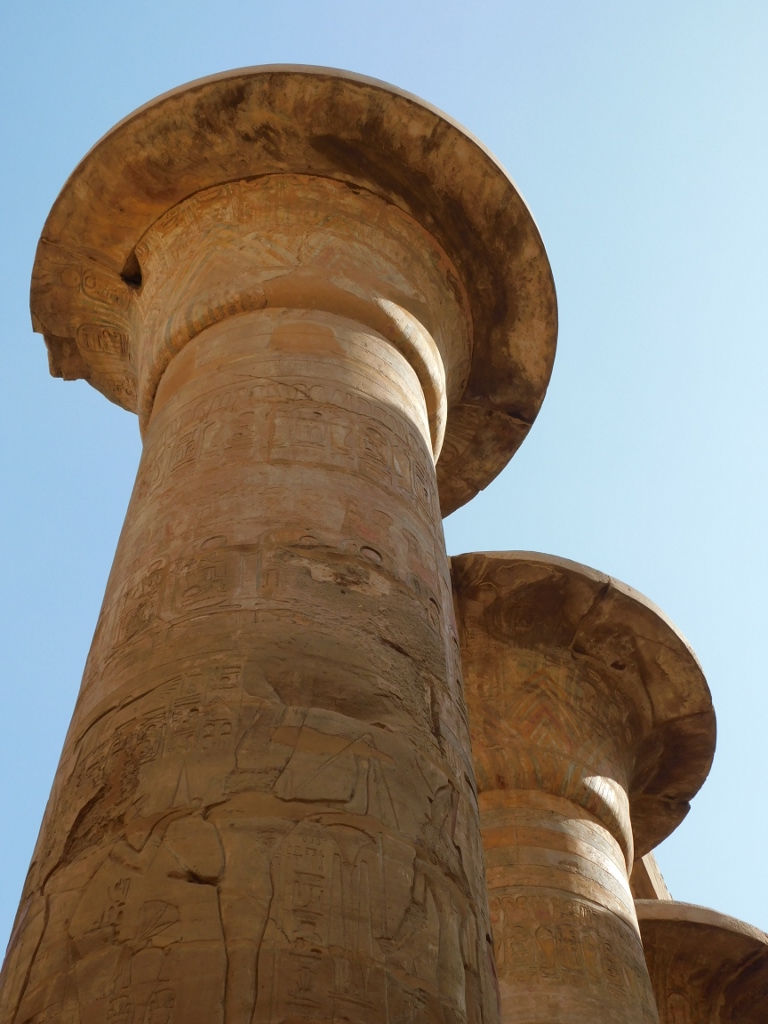 Central row of columns in the Hypostyle Hall, a detail
Central row of columns in the Hypostyle Hall, a detail
I have found this area so impressive, both times I was here, that I simply did not know where to look first. On many of these columns you can still see the colours, not to mention the reliefs.
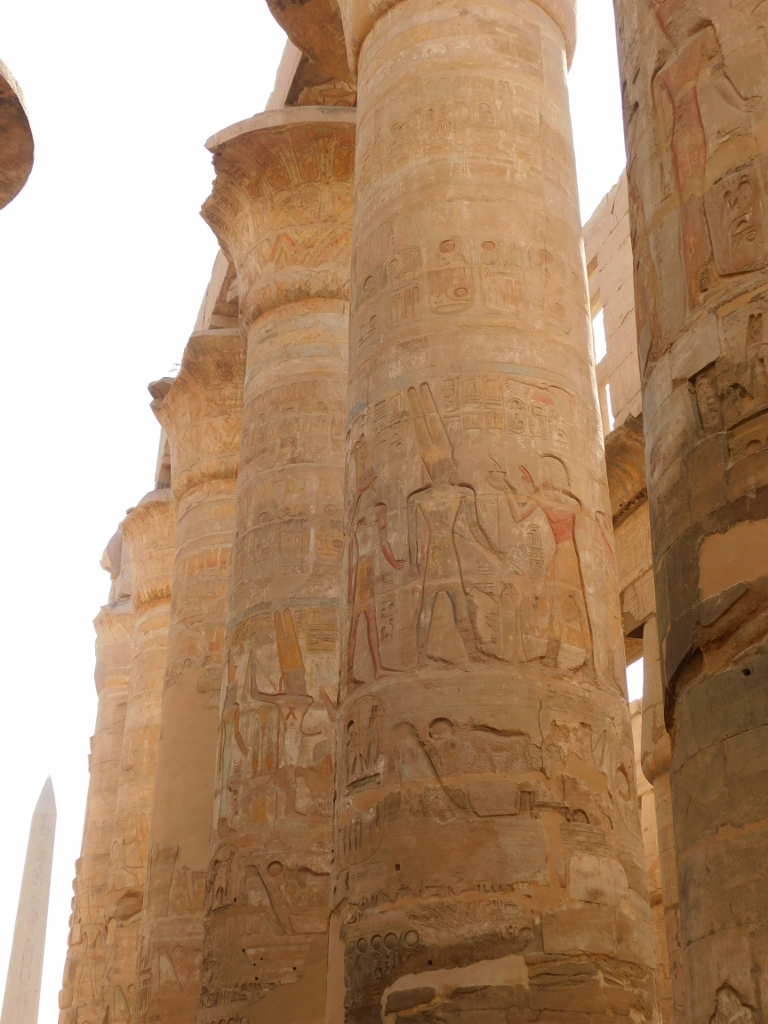 Central row of columns in the Hypostyle Hall
Central row of columns in the Hypostyle Hall
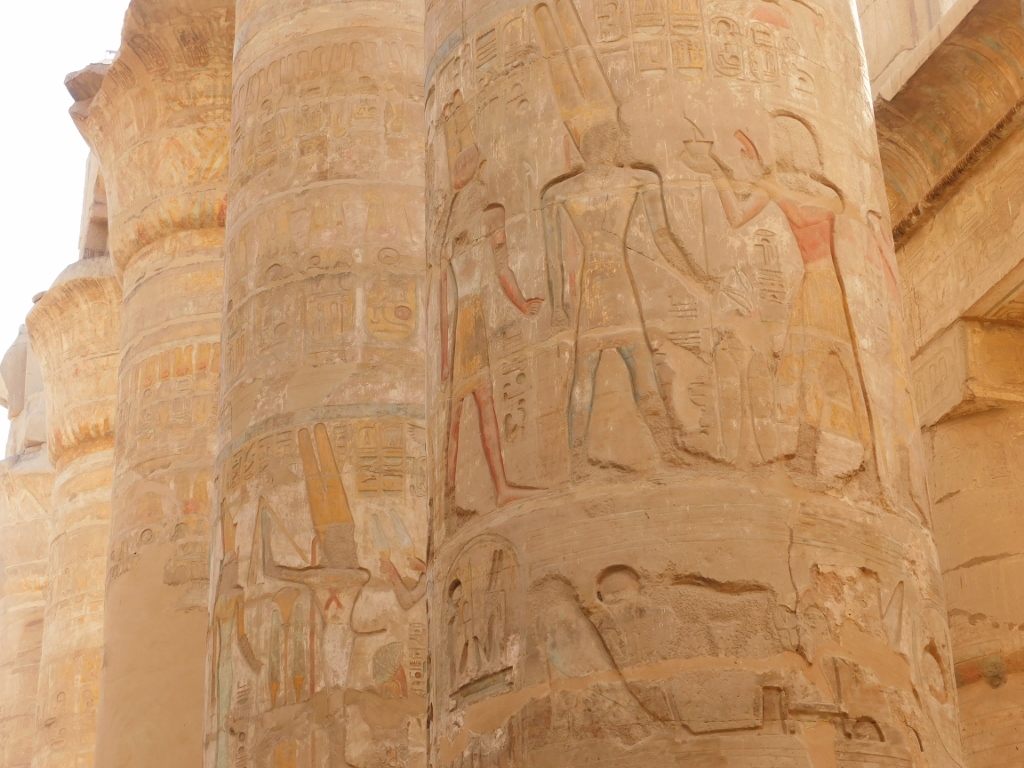 Central row of columns in the Hypostyle Hall, a detail
Central row of columns in the Hypostyle Hall, a detail
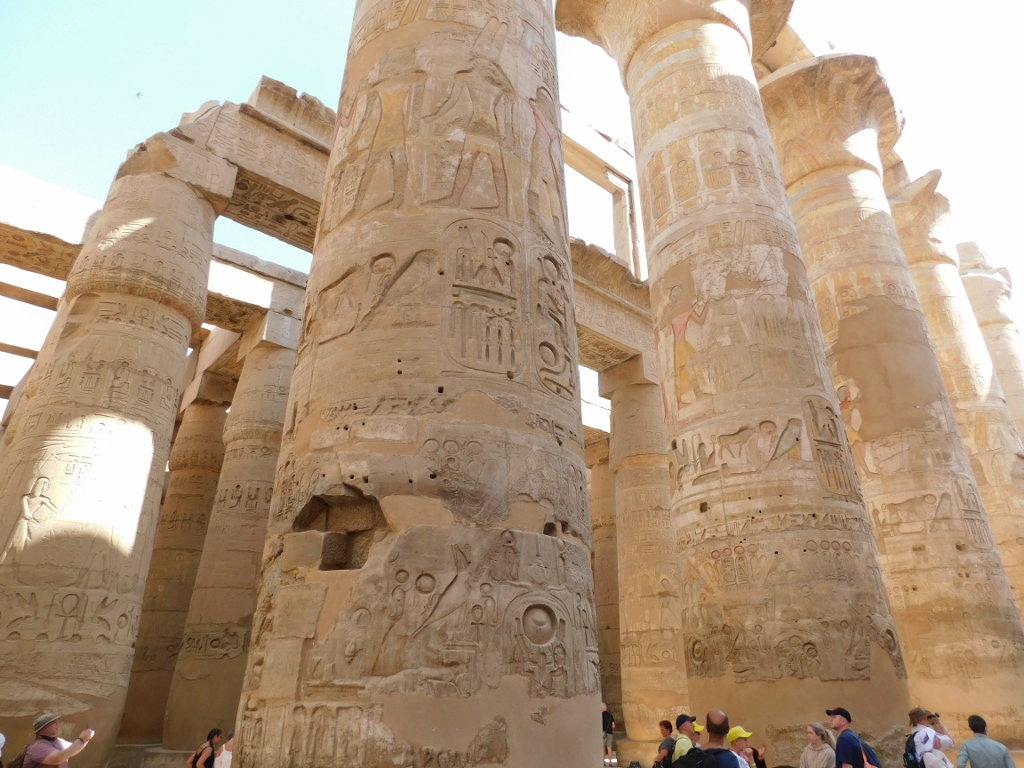 Central row of columns in the Hypostyle Hall in the foreground, the lower columns are behind
Central row of columns in the Hypostyle Hall in the foreground, the lower columns are behind
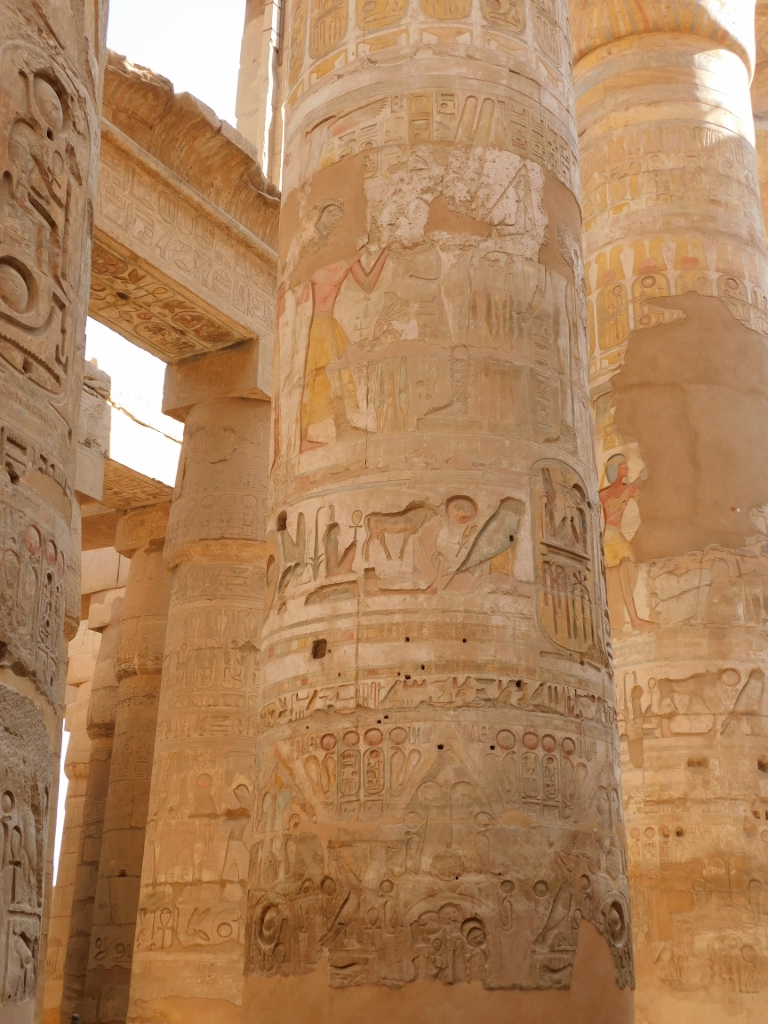 Central row of columns in the Hypostyle Hall, a detail
Central row of columns in the Hypostyle Hall, a detail
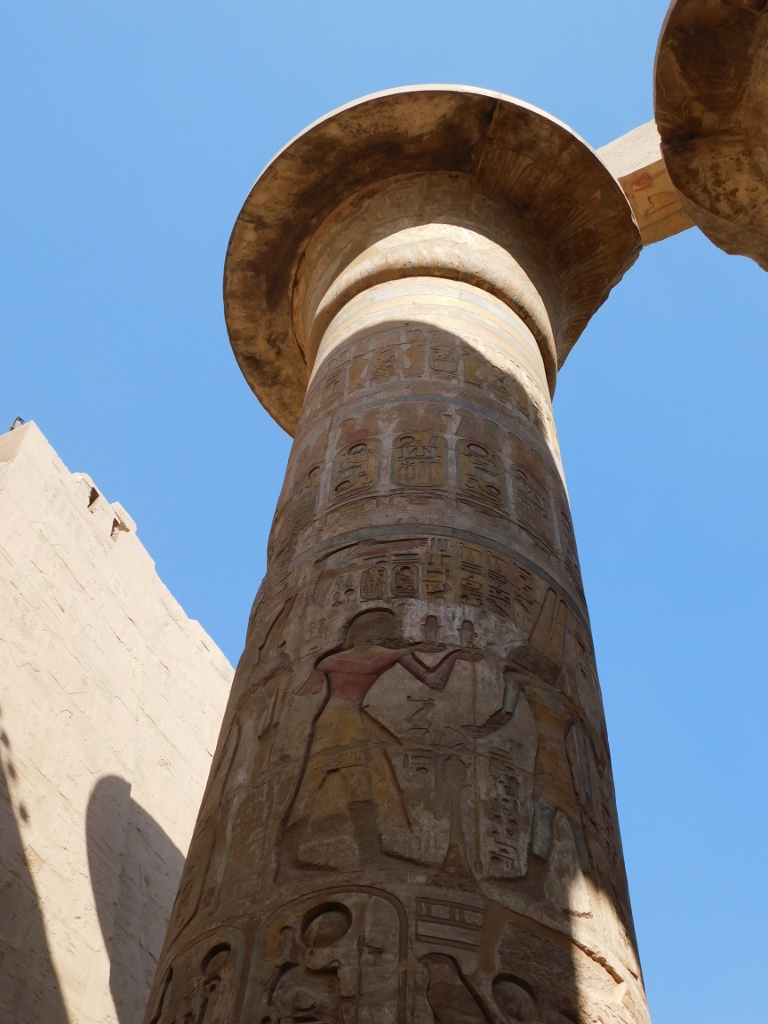 Central row of columns in the Hypostyle Hall, a detail
Central row of columns in the Hypostyle Hall, a detail
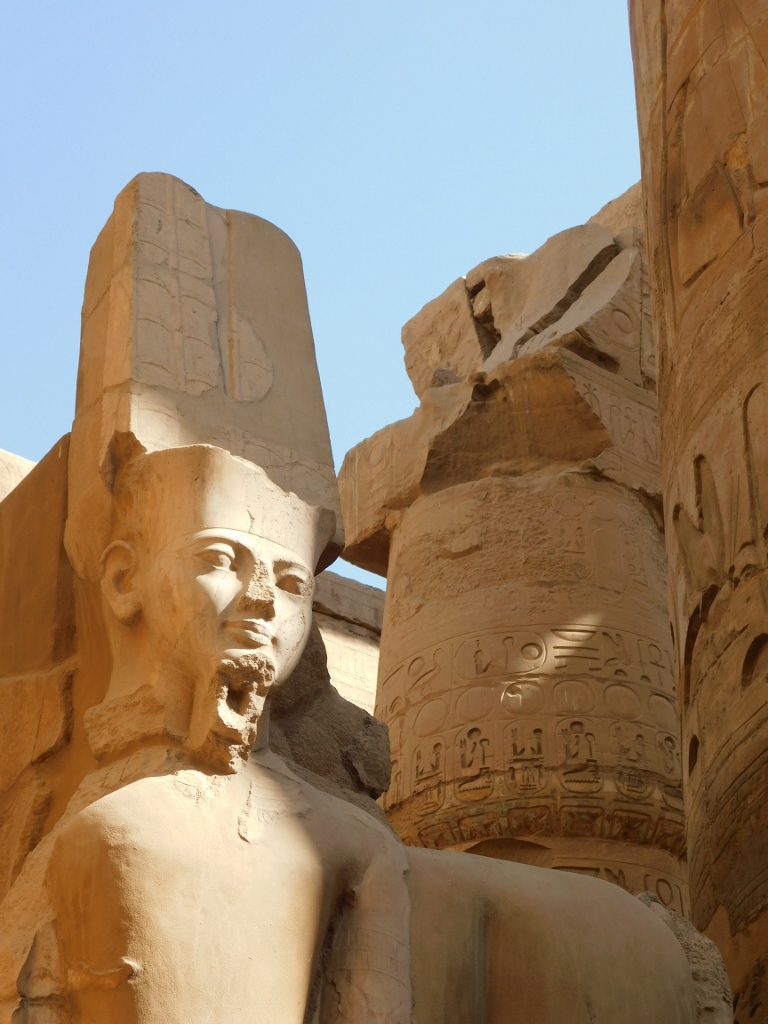 Hypostyle Hall, a detail
Hypostyle Hall, a detail
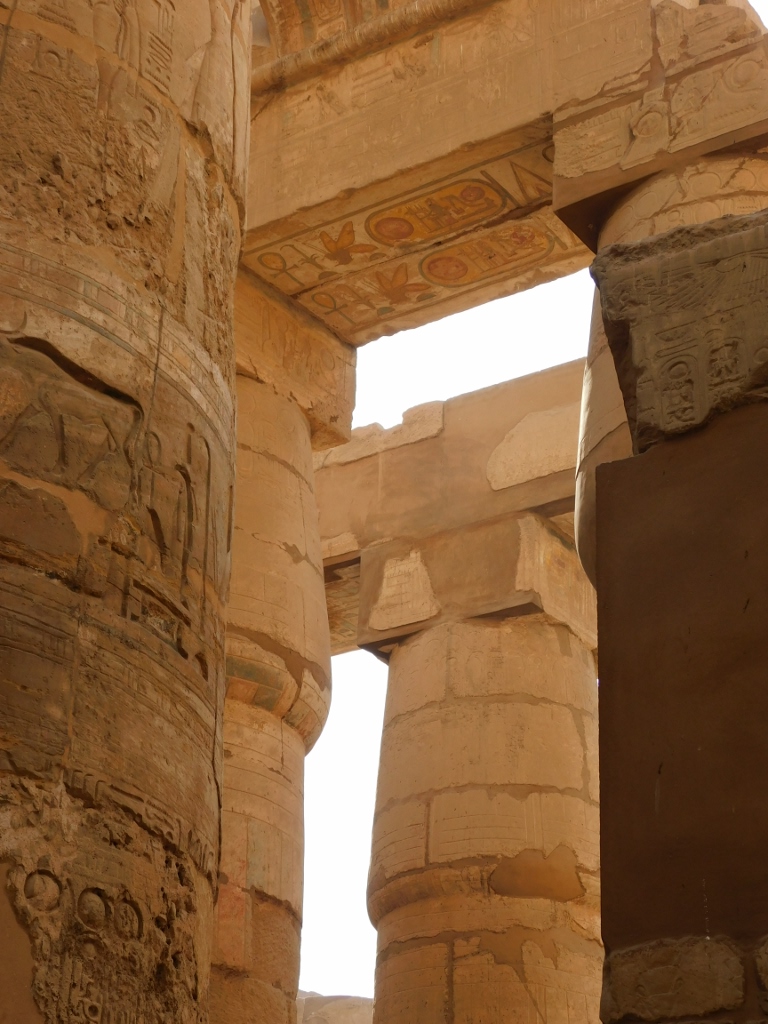 Hypostyle Hall, a detail
Hypostyle Hall, a detail
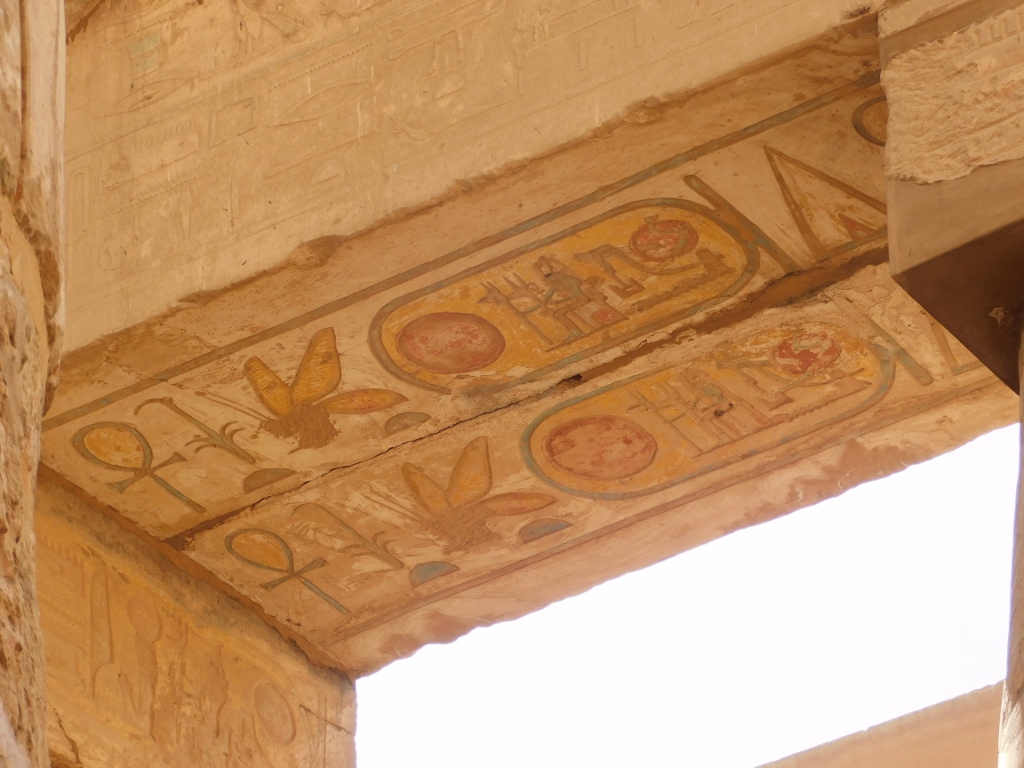 Hypostyle Hall, a detail
Hypostyle Hall, a detail
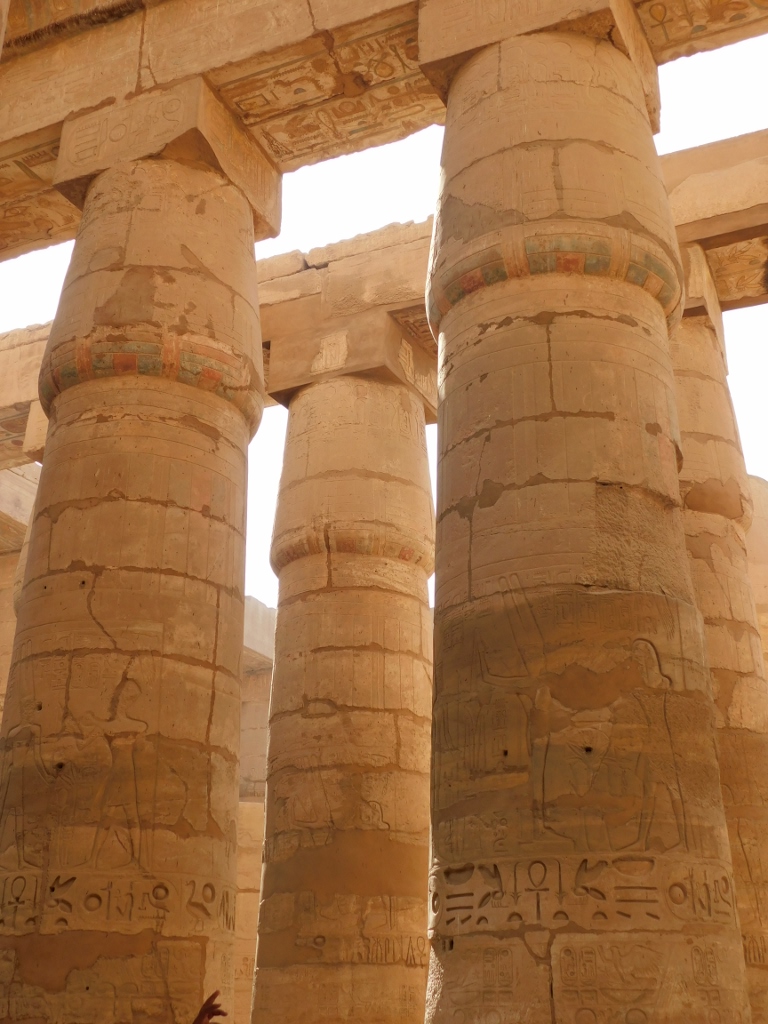 Hypostyle Hall, a detail
Hypostyle Hall, a detail
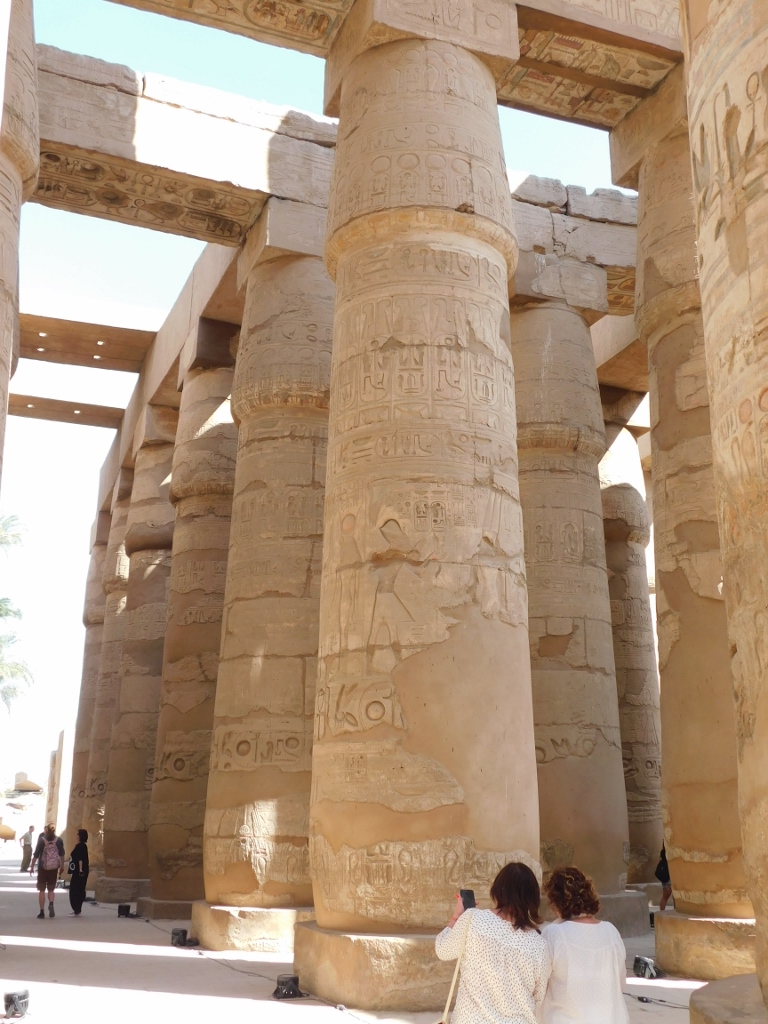 Hypostyle Hall, a detail
Hypostyle Hall, a detail
Still, no matter how massive and mighty these columns may appear, at the end of the 19th century, 11 columns toppled like dominos because of the action of the ground waters. Archaeologists have repaired this, but it is important to bear in mind that important places like this must be maintained regularly.
When exiting the Hypostyle Hall, but looking back, it is possible to see the remains of the stone roof structure.
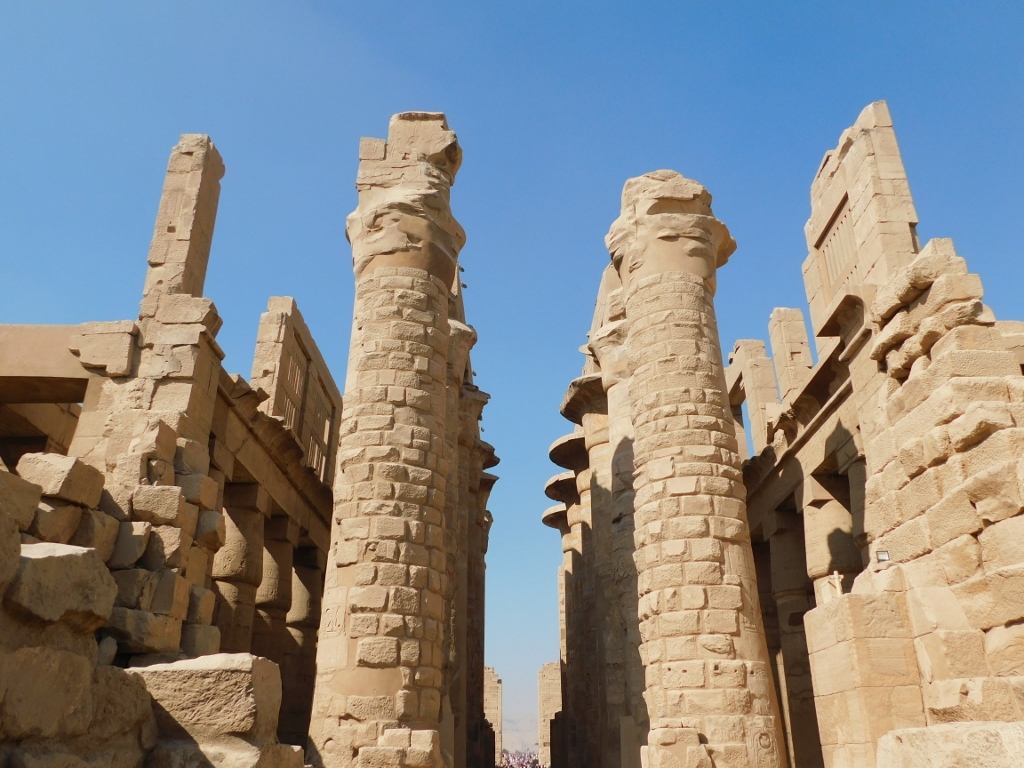 Hypostyle Hall, the back end
Hypostyle Hall, the back end
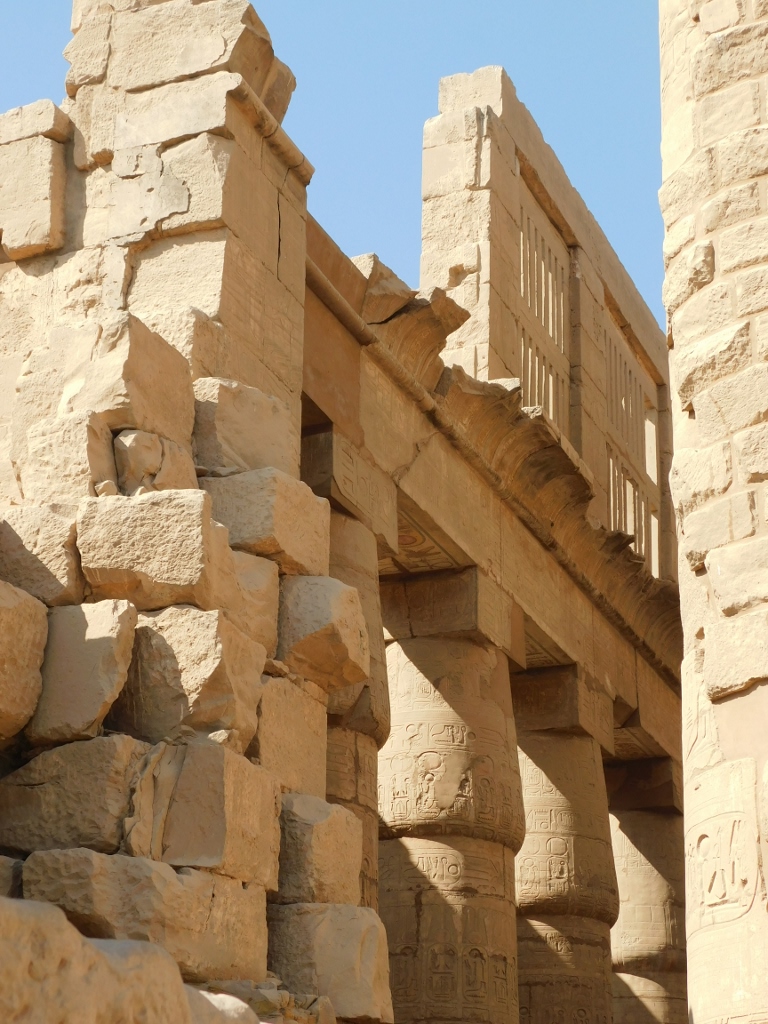 Hypostyle Hall, a part of the roof structure – the vertical walls have openings in order for the light to enter the interior of the hall
Hypostyle Hall, a part of the roof structure – the vertical walls have openings in order for the light to enter the interior of the hall
When you proceed along the central axis, you get to the Obelisk of Thutmose I, 21.2 m high.
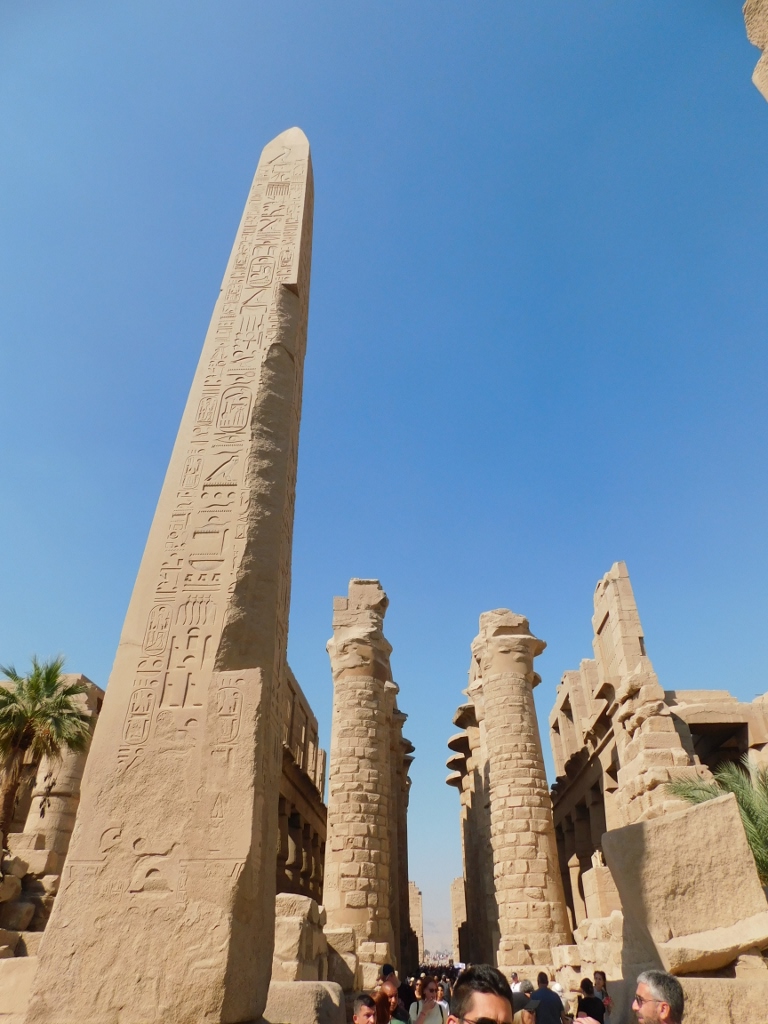 Obelisk of Thutmose I and the Hypostyle Hall in the background
Obelisk of Thutmose I and the Hypostyle Hall in the background
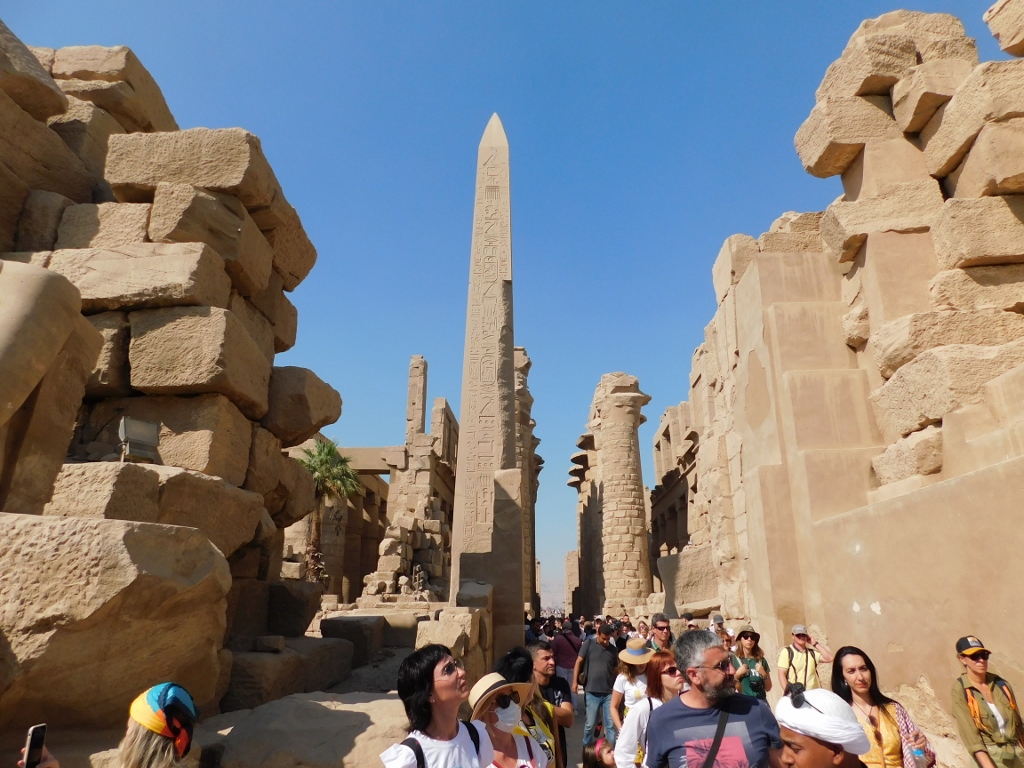 Obelisk of Thutmose I and the Hypostyle Hall in the background
Obelisk of Thutmose I and the Hypostyle Hall in the background
Close to this obelisk there is another one, almost 30 m high. This other obelisk was erected by female Pharaoh Hatshepsut (her reign: 1479-1458 BCE).
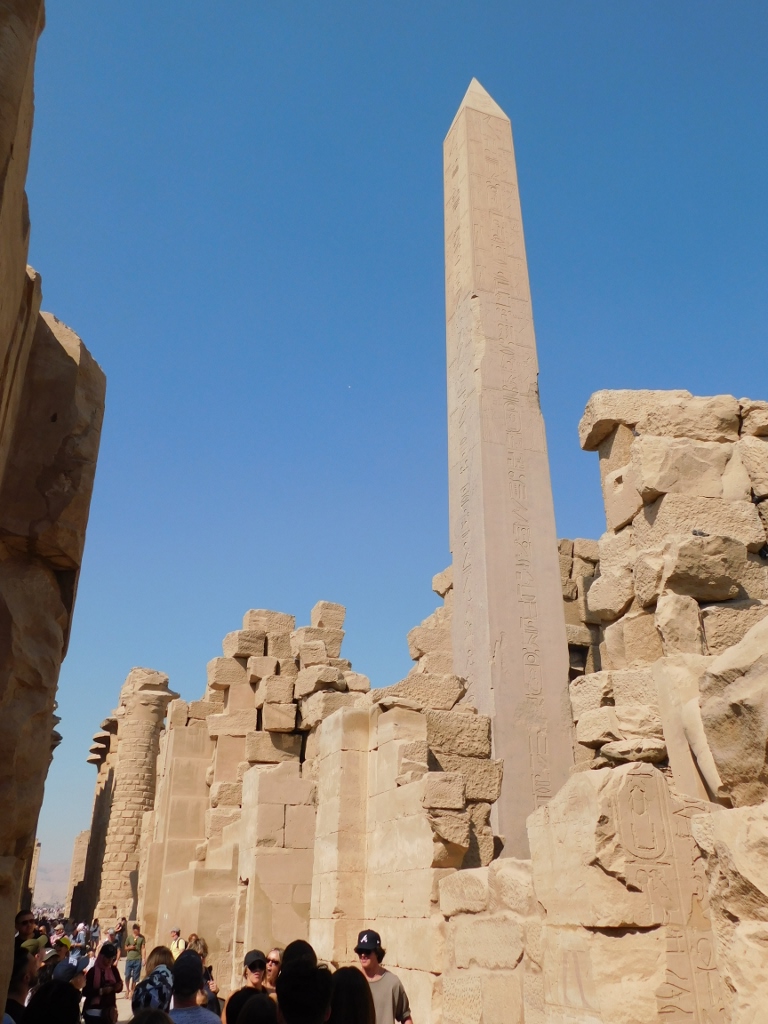 Obelisk of Pharaoh Hatshepsut and the Hypostyle Hall in the background
Obelisk of Pharaoh Hatshepsut and the Hypostyle Hall in the background
I will later say something more about Hatshepsut herself, but what is interesting to mention here is that, since she was not popular after her death, the subsequent pharaohs had their structures built very close to her obelisk so that it could almost not be seen. The time and the demise of these structures have certainly remedied this and nowadays the obelisk can be seen quite nicely. This is also the highest free-standing ancient obelisk in the world.
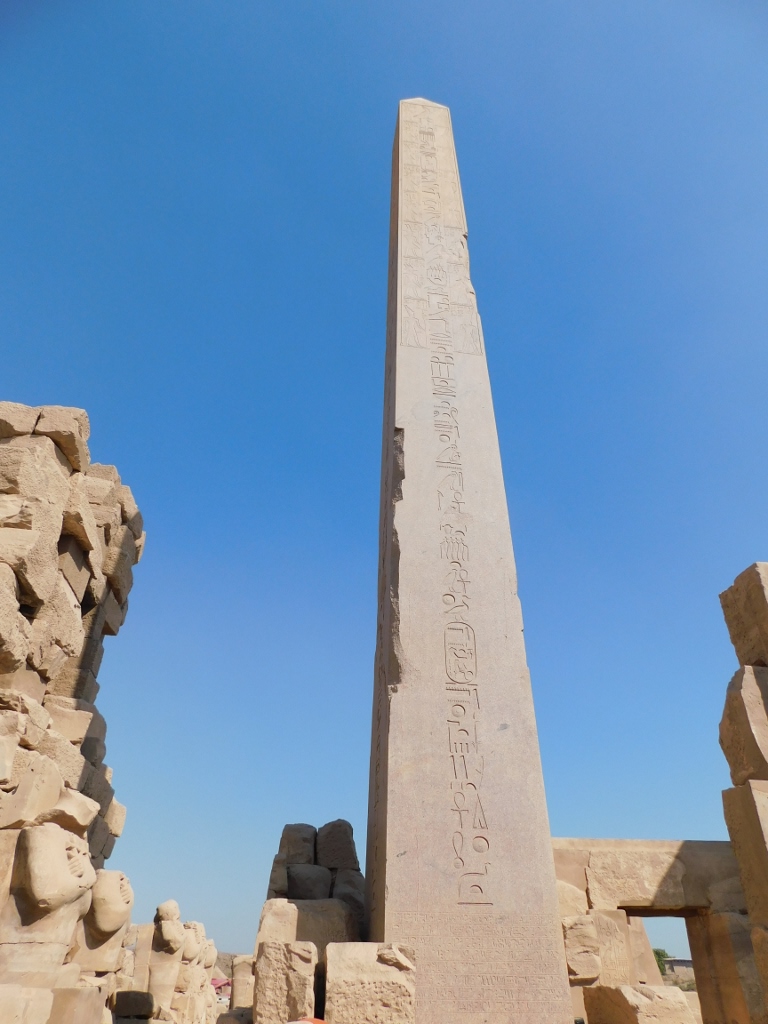 Obelisk of Pharaoh Hatshepsut
Obelisk of Pharaoh Hatshepsut
Since Pharaoh Hatshepsut was one of the most prolific builders in Ancient Egypt, she actually had two obelisks erected here, but the other one broke and fell. And so, not far from here, beside the Sacred Lake, it is possible to see the top of that other obelisk.
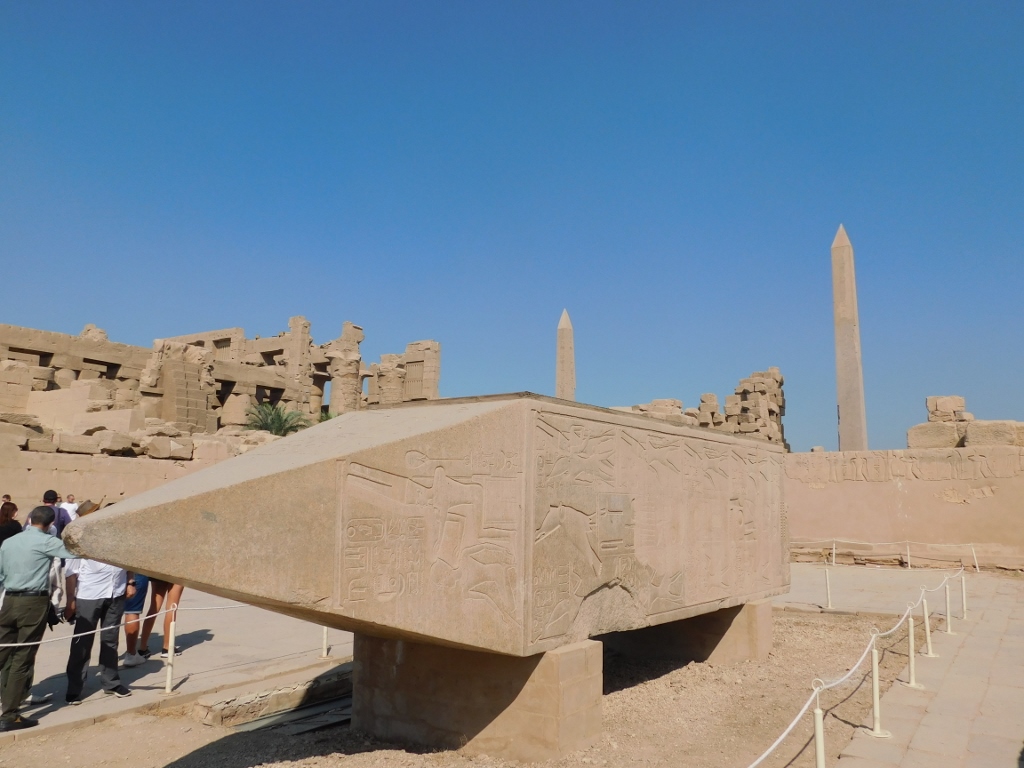 Top of the other obelisk of Pharaoh Hatshepsut
Top of the other obelisk of Pharaoh Hatshepsut
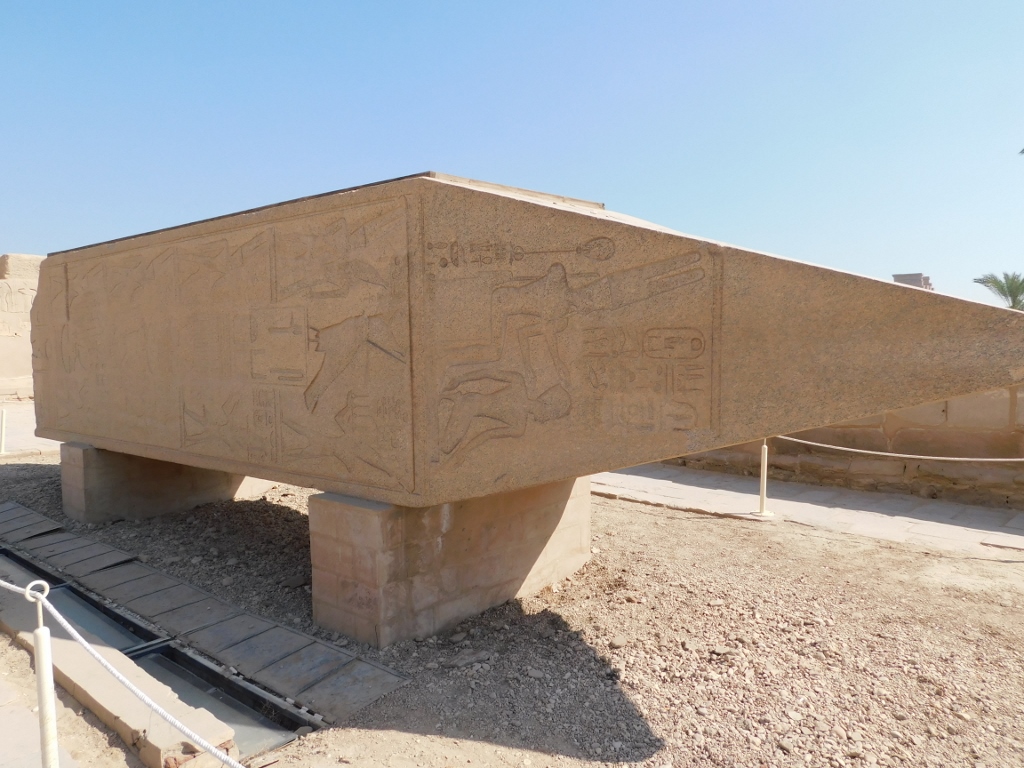 Beautifully carved top of the other obelisk of Pharaoh Hatshepsut
Beautifully carved top of the other obelisk of Pharaoh Hatshepsut
Pharaoh Hatshepsut did not stop here and she ordered the construction of two more obelisks, but one of them broke during the making and was left at the quarry in Aswan. You can read about this and see the unfinished obelisk in: (https://svudapodji.com/en/egypt-3/). This unfinished obelisk is exceptionally important because it shows the obelisk-making technique.
Originally, there used to be 17 obelisks at Karnak. In addition to the two that are still standing, one of them was moved to Constantinople in the 4th century CE and can be seen today in Istanbul (see: https://www.svudapodji.com/en/istanbul-1/), while another one was moved to Rome and placed there. The remaining obelisks have, like the one described above, simply toppled and thus they broke.
At this point, in November 2021, I simply left the group and continued with the sightseeing on my own. A myriad of details could be seen all around.
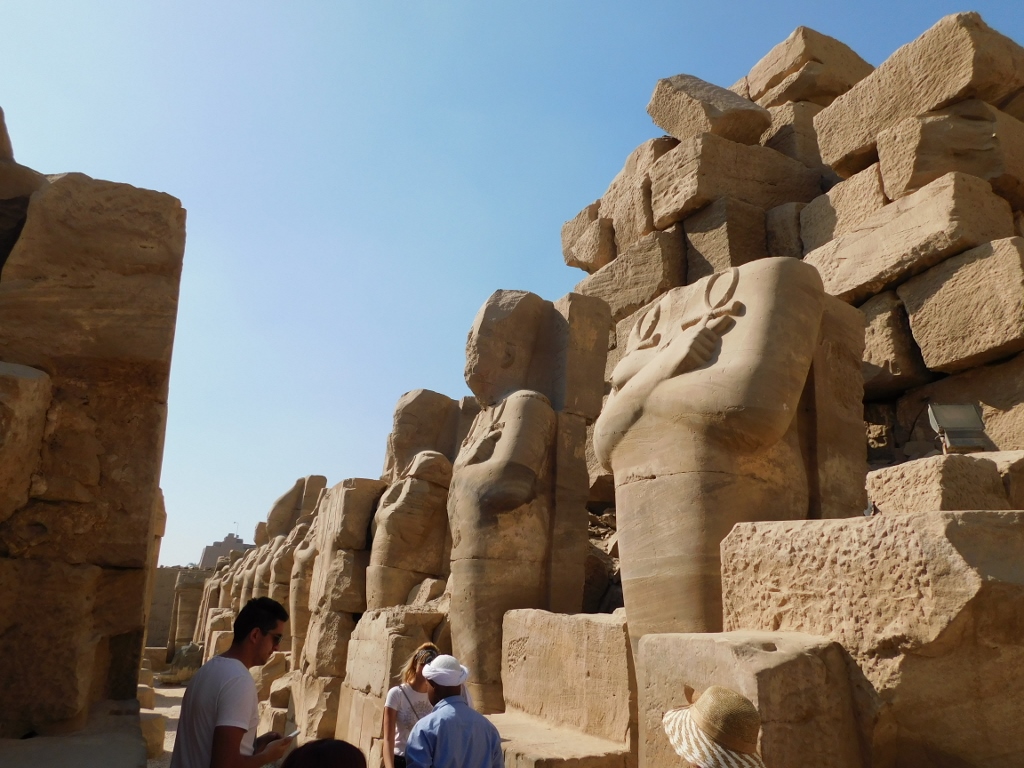 Parts of the Temple of Amun in Karnak
Parts of the Temple of Amun in Karnak
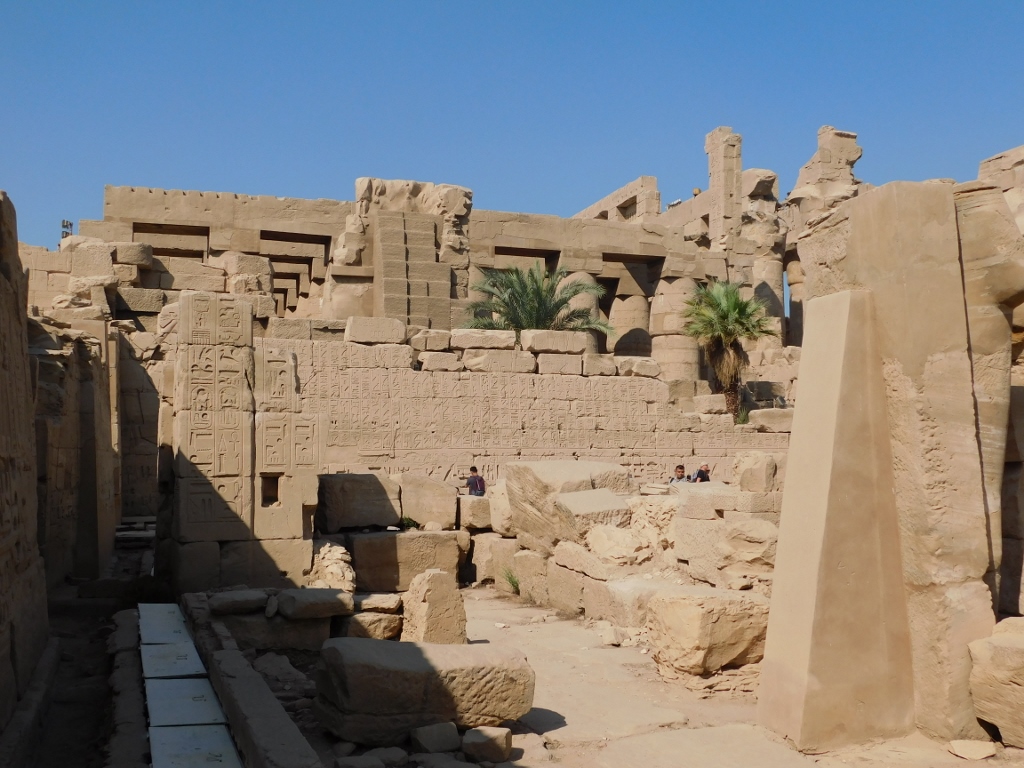 Parts of the Temple of Amun in Karnak
Parts of the Temple of Amun in Karnak
Then I also went to the Sacred Lake. The lake was used by the priests in order for them to get purified before performing the rites.
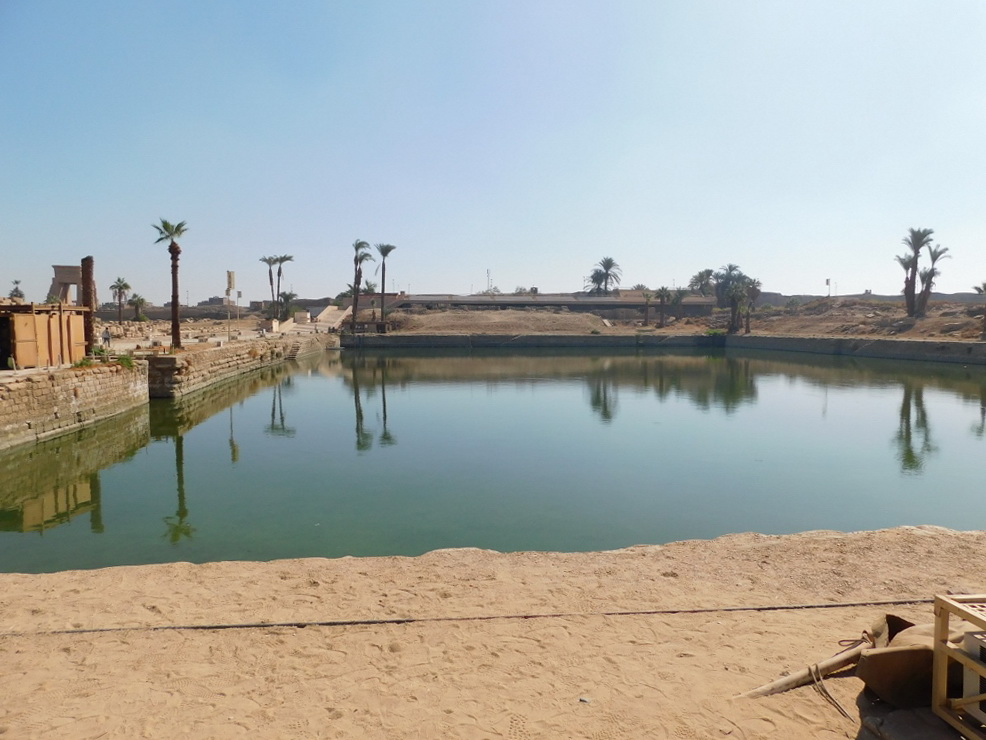 Sacred Lake
Sacred Lake
In addition to the top of the fallen obelisk, there is also a large sculpture of a scarab near the Sacred Lake. Scarab is also known under the unflattering name of dung beetle. Still, it is perhaps precisely because of this processing of someone else’s waste and the laying of eggs, i.e., the germ of the new life, in something that has already been discarded through casting out by somebody else that the scarab was exceptionally revered in Ancient Egypt as the symbol of renewal and rebirth. The most famous amulets in Ancient Egypt were precisely in the shape of a scarab.
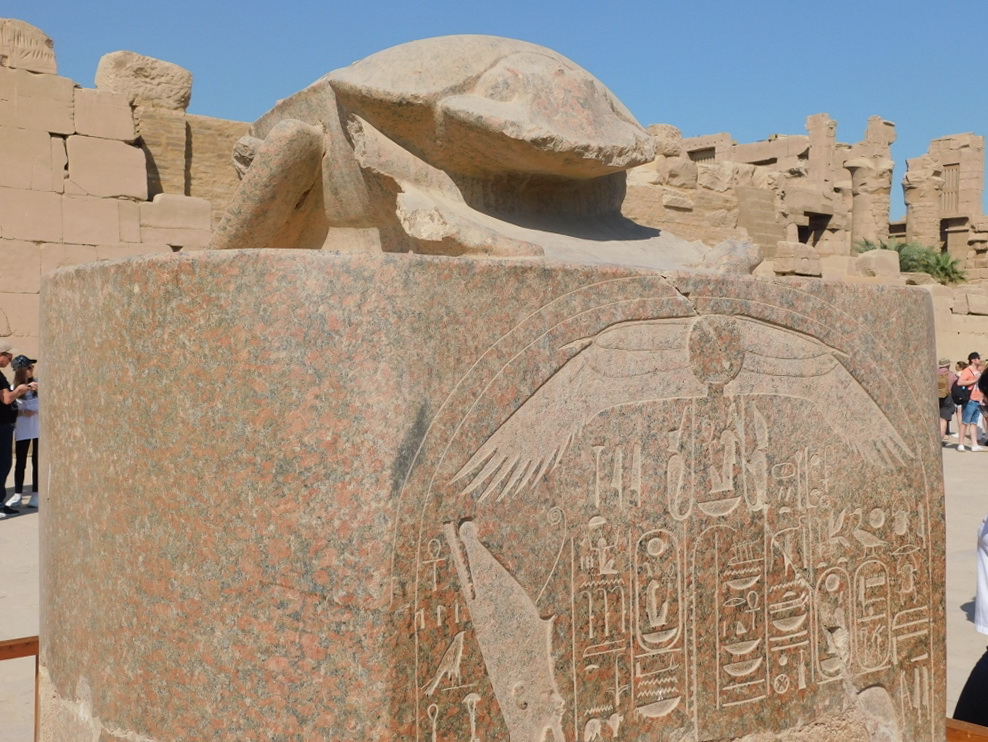 Large scarab on a stone pedestal
Large scarab on a stone pedestal
The guides tell the visitors here that walking three times around the scarab brings luck and this is precisely what you can see when you get to the scarab sculpture. In the past, the guides used to say that only men should go around three times, while women had to do it five times (in order to be lucky). Now, when PC and gender equality reign supreme, this has all come down to the same figure for both sexes.
From here I looked wistfully towards the south parts of the Temple of Amun which I knew I would not be able to visit on this occasion. The larger structures seen in the photo below are the remains of pylons (from no. 7 to no. 10).
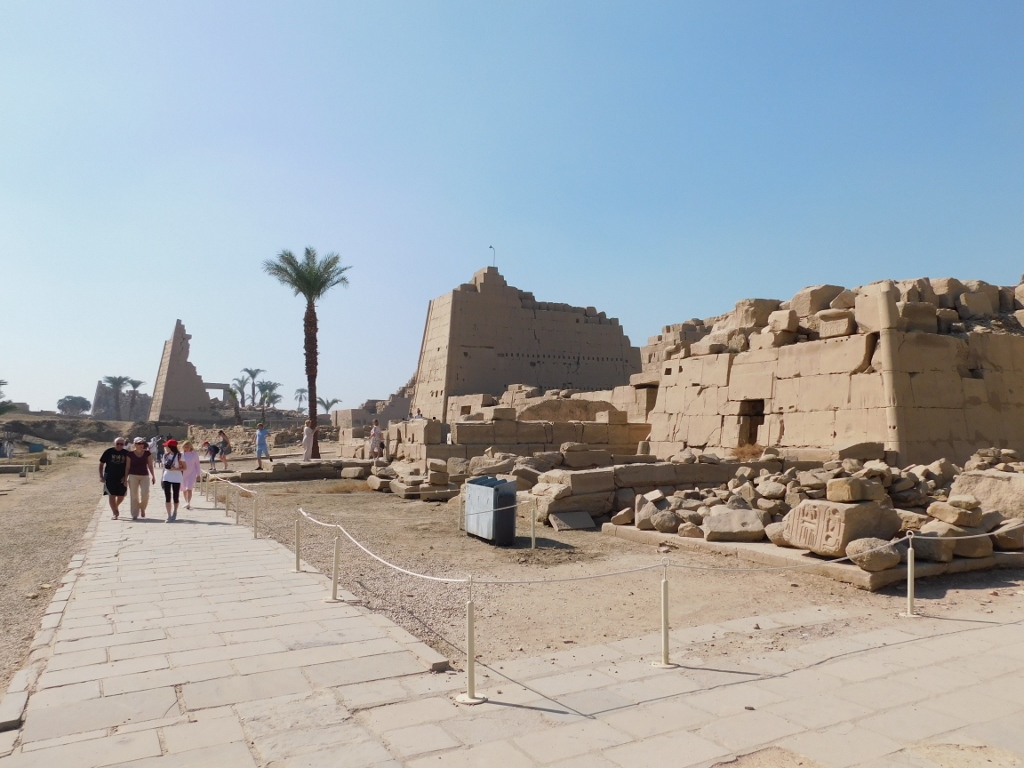 South sections of the Temple of Amun and the remains of the pylons
South sections of the Temple of Amun and the remains of the pylons